
Egyptian Style Face Powder
Marietta Stanley, ca. 1906-1925
Nyalis Face Powder
Nyal Company, ca. 1919-1926
Velvetina Egypta Face Powder
Goodrich Drug Company, ca. 1917-1930
Ancient Egypt’s appeal was harnessed by cosmetic companies well over a decade before the opening of King Tut’s tomb in 1922 and the ensuing wave of Egyptomania, particularly in design. Nyal’s Nyalis powder box features a sphinx stonily gazing out of a triangle set in the center of the box, flanked by an ornate gold and blue lotus flower pattern. Like most face powders of the early 1900s, Velvetina’s Egypta was part of a larger toiletries line intended to accompany the brand’s Egypta fragrance. While the powder and other items were introduced in 1915, in 1917 the company released a new box for the face powder: a “beautiful new style Oriental design bronze green and straw colored boxes,” according to one ad. In the center a silhouette of a woman’s head shows a crown with an uraeus, the stylized, rearing cobra that symbolized divine authority and is associated with the goddess Wadjet. Marietta Stanley’s Egyptian face powder box features an illustration of a woman wearing an elaborate floral headdress with a faint outline of pyramids in the background.
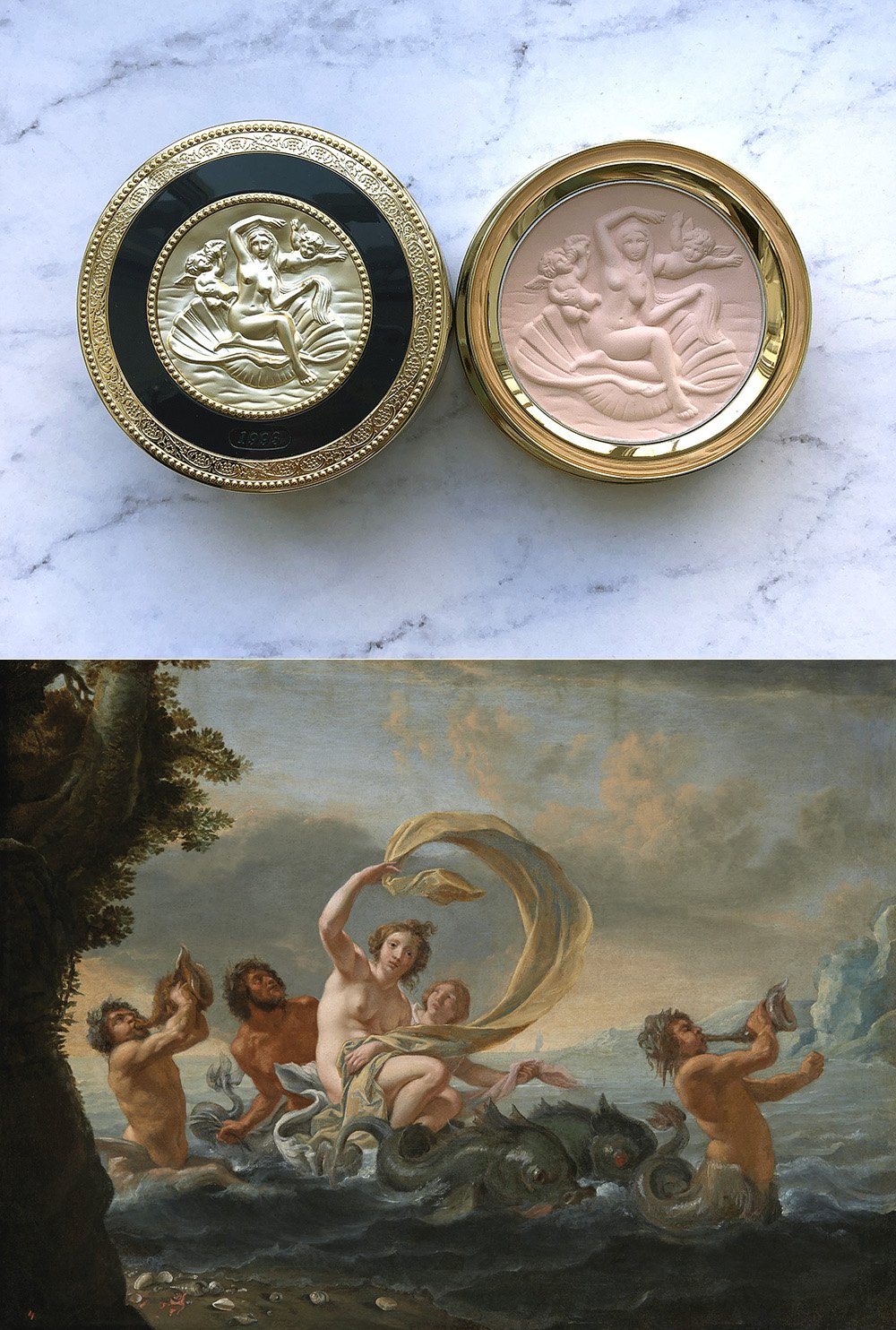
Milano Compact
Kanebo, Holiday 1993
Beginning in 1991, each holiday season Japanese company Kanebo releases ornately designed compacts featuring goddess-like figures whose draping and poses referencing allegorical paintings of the Neoclassical era. With a seashell throne, flying putti, and the goddess's raised arm, the scene depicted in the 1993 compact appears to reference several 17th and early 18th century paintings, namely Simon Vouet's The Triumph of Amphitrite, Michele Rocca's The Triumph of Venus, and Paolo Matteis's The Triumph of Galatea.
For more information, see the Makeup Museum’s article on Kanebo’s holiday compacts.
Image via Wikimedia Commons

Compact
Rex, ca. 1940s
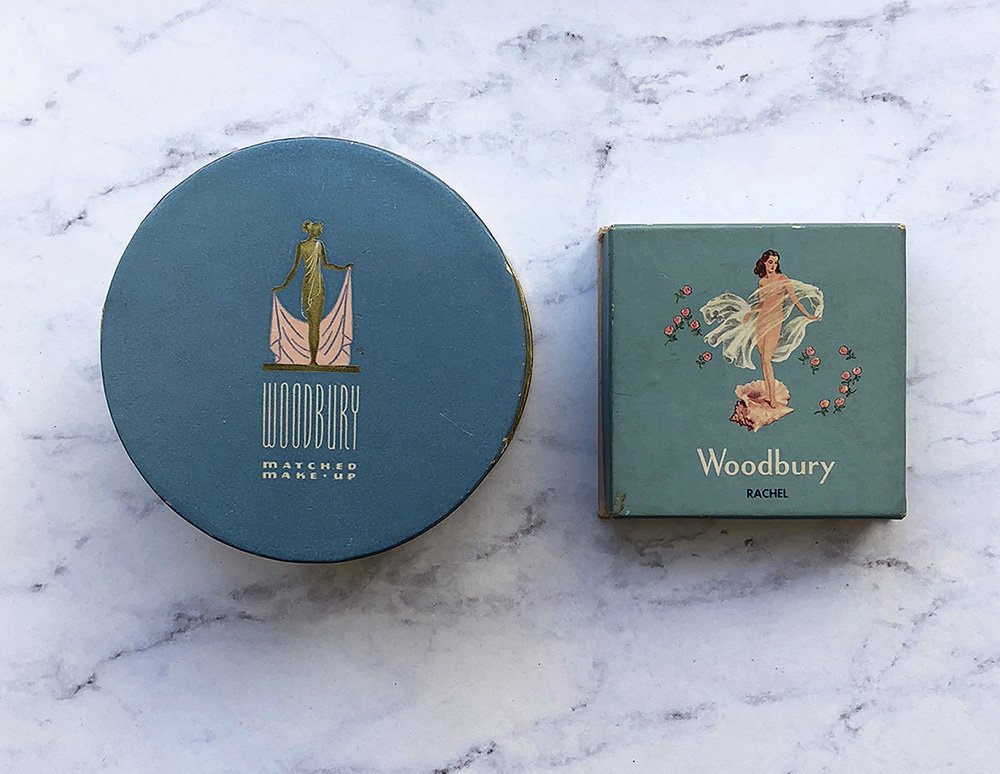
Matched Makeup Kit and Powder Box
Woodbury, ca. 1941-1947 and 1948-1954
The Woodbury Company changed its packaging frequently throughout its 100-year history and began incorporating goddess imagery in the early 1930s. According to Modern Packaging, in 1948 Woodbury completed an in-depth marketing study, working with advertising agency Robert W. Orr and Associates and surveying over 2,000 people. The company determined the goddess logo was too generic, and the Greek key pattern especially was getting stale due to its ubiquity. “The key motif, through wide usage for decoration in other fields to suggest classic beauty, had also lost much of its distinctiveness and identity.” Three new designs were offered, including an illustration of Venus standing atop a shell and surrounded by delicate pink blooms, which directly referenced Botticelli’s The Birth of Venus. This design was ultimately selected despite not being the first choice among survey participants, as the company felt the Venus and flower combination was both modern and timeless: “[The Venus design], it was decided, had the basic elements of style and good taste regardless of temporary fashion trends. Here could be a goddess of beauty as a flesh and blood symbol of all Woodbury beauty products – a great advance over the cold abstract figure used on the previous Woodbury powder box. With the striking, modernized Venus theme were incorporated delicate pastel flowers as an incidental part of the design, thus combining the long-known foolproof motif in cosmetic packaging with a new identifying symbol, but overcoming any objections to a purely floral design.” Venus’s status as the epitome of physical beauty and femininity became directly tied to Woodbury’s products, following a long tradition of this depiction in Western art.
Modern Packaging, July 1948, p. 85-89.
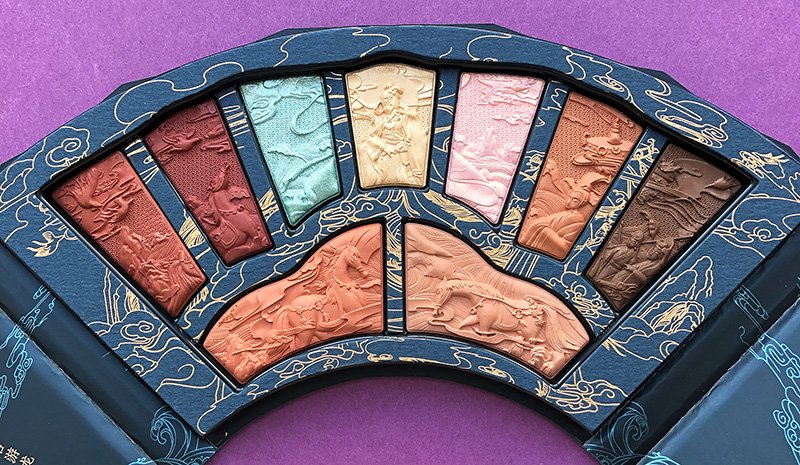
Floral Engraving Odey Makeup Palette
Florasis, 2021
Florasis was founded in 2017 and incorporates traditional Chinese art and culture across their entire product line. This palette features scenes from the poem “The Nymph of the Luo River”. The poem was written by Cao Zhi (192-232 CE) and painted on a massive scroll originally by Gu Kaizhi (ca. 344-406 CE). Cao Zhi tells a tale of visiting the Luo river with his servants and his brief, ultimately unsuccessful love affair with a beautiful nymph/goddess. The palette’s concept connects ancient and modern beauty ideals, while the ad copy emphasizes the idea of transformation from human to divine being: “We’d like you to meet our most intricate palette yet, a truly seamless and multifunctional product to enhance the goddess in every woman.”
For more on Florasis, see the Makeup Museum’s article.
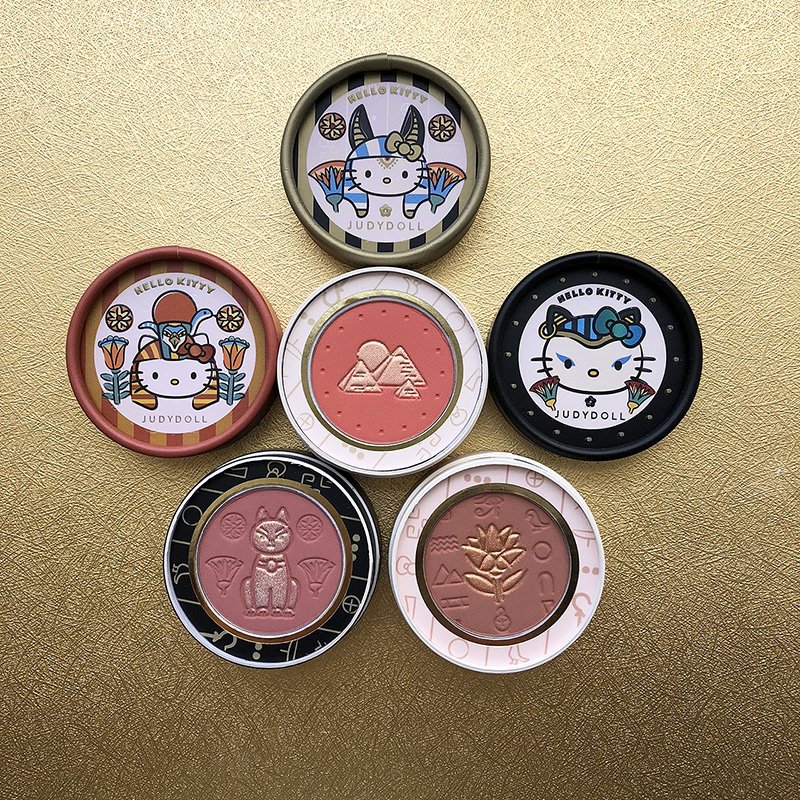
Egyptian Adventures Blushes
JudyDoll, 2020
Like fellow Chinese brand Zeesea, newcomer JudyDoll took advantage of the licensing available from the British Museum to use the institution’s name and motifs inspired by its Egyptian artifacts on a makeup collection. Unlike Zeesea, however, JudyDoll injected a more playful vibe by incorporating a Hello Kitty license as well. The result is a charming mishmash of references and styles that appeals to a wide audience, albeit far removed from ancient Egyptian history.
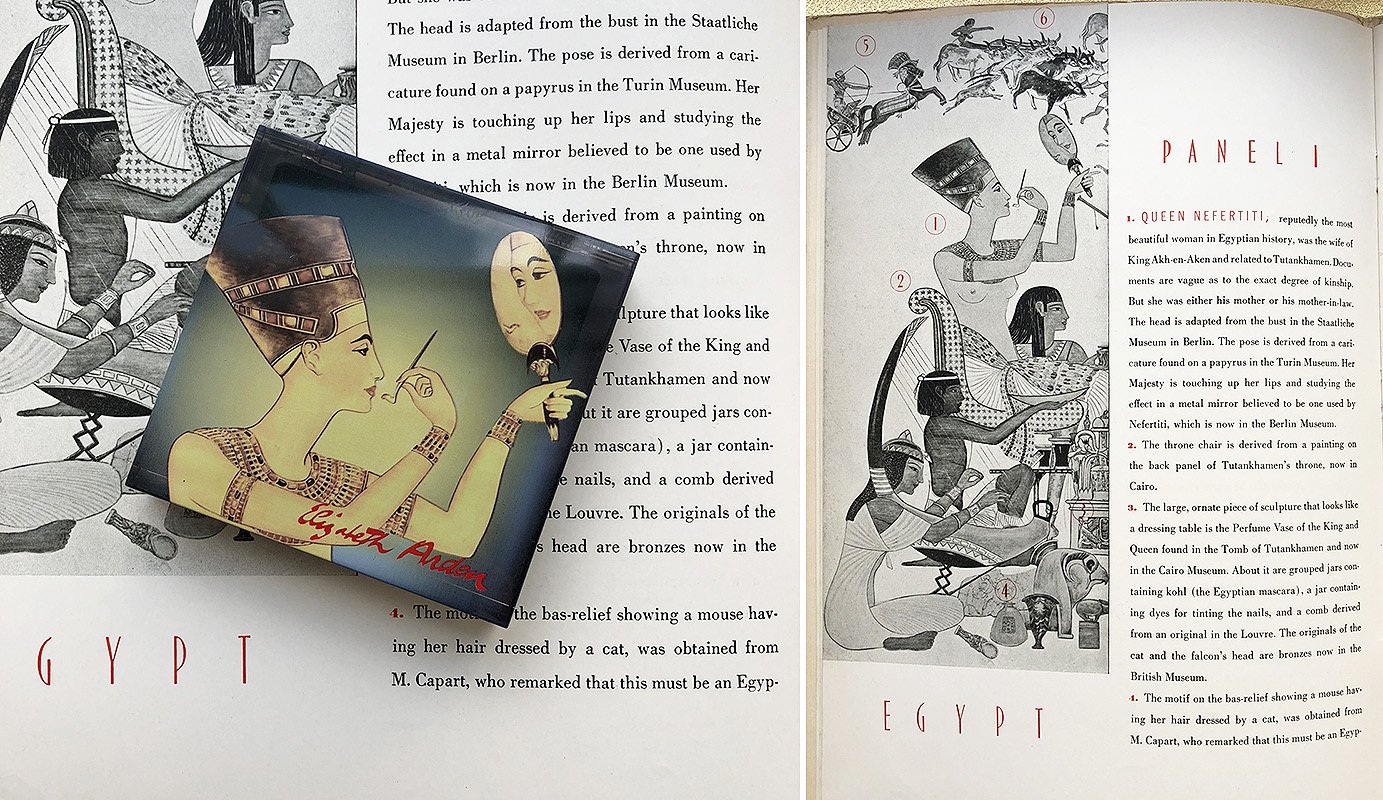
Eyeshadow Quad
Elizabeth Arden, Fall 2006
The Sueded Browns quad was part of a collection consisting of 3 eyeshadow palettes featuring a vignette from “A Pageant of Beauty”, a 70-ft-long, 14-panel mural commissioned by Elizabeth Arden in 1935. Painted by prominent American artist Clara Fargo Thomas, the mural “embodied the story of woman’s insistence on loveliness throughout the ages,” according to Ralph Flint, author of the mural’s guidebook. Here Nefertiti, surrounded by her beauty accoutrements and servants, gazes into a mirror to touch up her lip color. It should be noted that the “caricature found on a papyrus in the Turin Museum” on which the queen’s pose is based refers to a scroll depicting prostitutes preparing for their clients. Thomas may have been slyly commenting on the long-held notion that makeup was the domain of sex workers and not “respectable” women, which persisted in the 1930s despite the efforts of large companies such as Arden to make cosmetics socially acceptable.
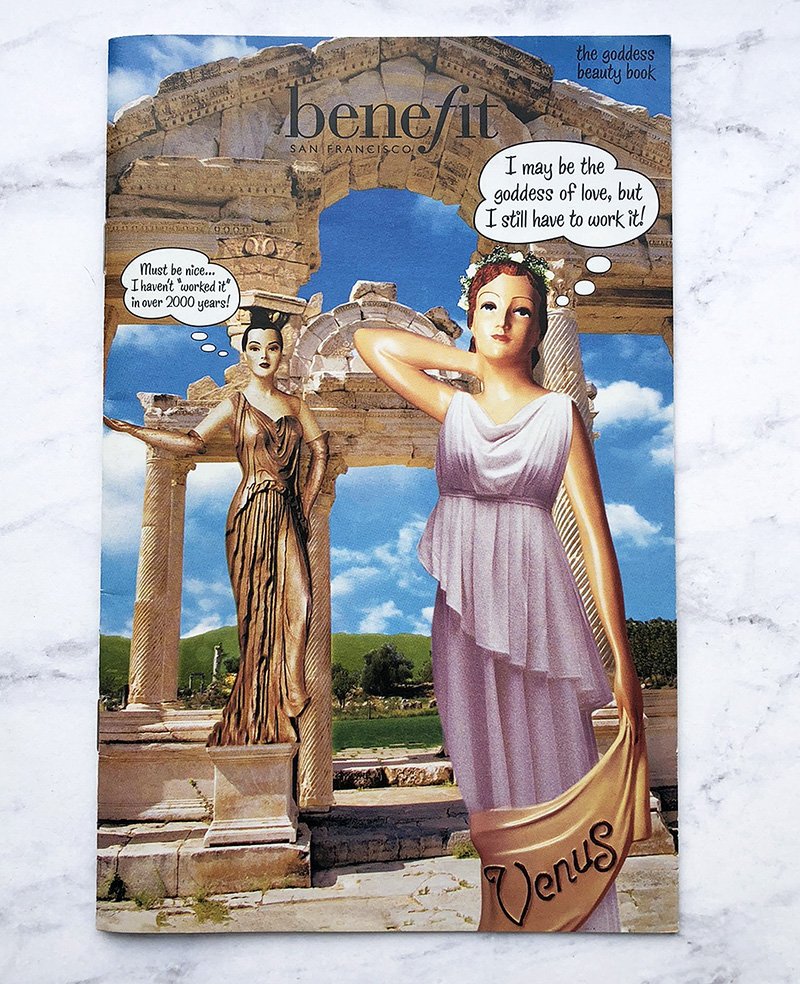
Catalog
Benefit Cosmetics, 2007
The vintage mannequins used by Benefit as their unofficial mascots received a goddess makeover for the company’s summer 2007 catalog. Founders Jean and Jane Ford allude to their products’ transformational ability that turns the average woman into a divine being. By using Benefit, customers can shed the banality that comes with being mortal without also losing their humanity. “All we know is that from time to time it’s wonderful to feel like a goddess, to look like a goddess and be told, ‘You’re a goddess.’ We are the goddesses of makeup, always mixing up new magic for your face and body…goddesses aren’t real, but we are. We get zits, have jobs, do laundry, stroll our babies and blow kisses to our significant others. We like being human. If you’re created in stone, it’s really hard to crack a smile.”
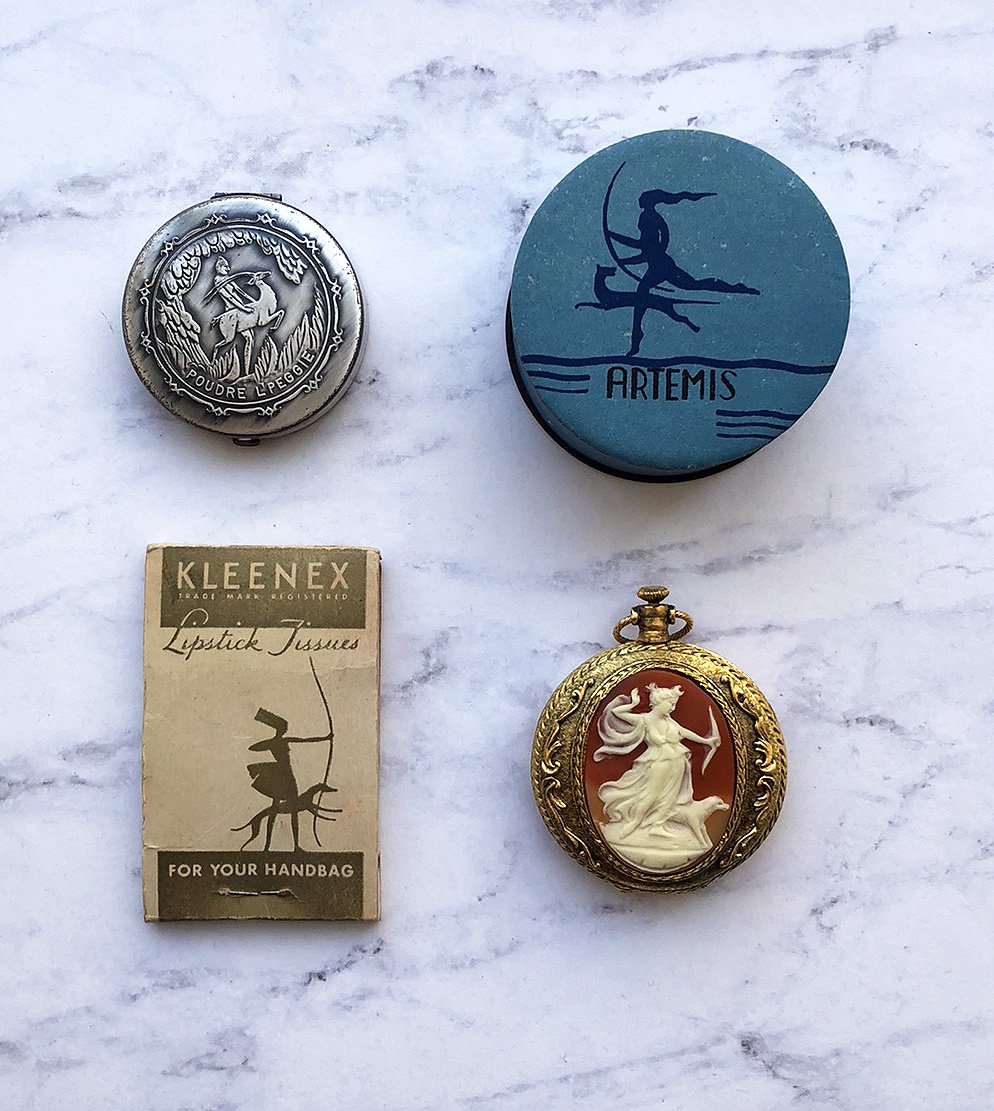
Powder Compact
L’Peggie, 1926-1933
Face Powder
Artemis, 1925-1926
“Enchanted Forest” Compact
Max Factor, ca. 1973-1976
Lipstick Tissues
Kleenex, ca. 1937-1940
The goddess of the hunt, Artemis (or the Roman version Diana), appears to be the second most referenced goddess behind Aphrodite/Venus in makeup advertising. In contrast to the sensual beauty and vanity associated with the goddess of love, Artemis symbolizes bodily freedom and humanity’s bond with the natural world. Whether draped in flowing robes or tastefully nude, as a stylized warrior or enjoying the forest with her hunting dogs and arrow, the figure of Artemis offers an alternative to traditional beauty signifiers by linking classical ideals to strength and lack of artifice.

Advertisements
Germaine Monteil, 1944
Cutex, 1961
Ancient Greek and Aztec cultures are treated very differently in ads by Germaine Monteil and Cutex. Greece is held in the highest regard (one of the “civilizations most noted for their achievements”), while the Aztecs are referred to as “primitive”. Additionally, the Chac Mool sculpture which the models use as a mere prop to show off their manicures is from the ancient Mayan site of Chichen Izta.
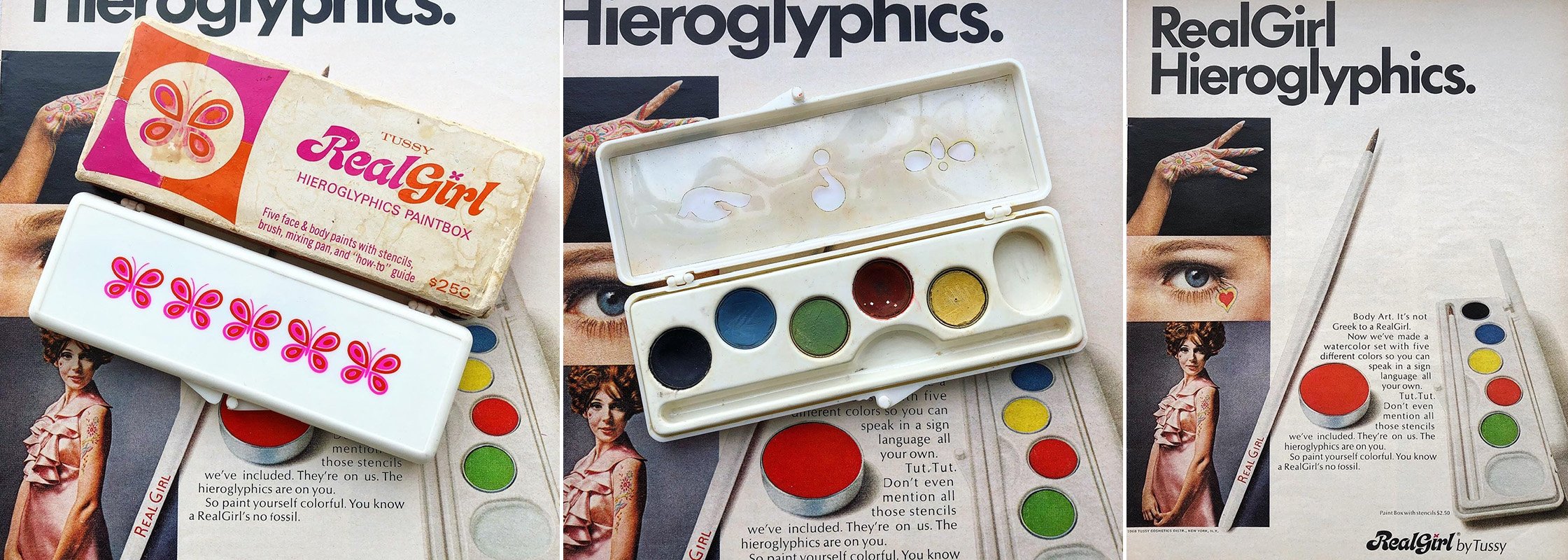
Real Girl Hieroglyphics Paint Kit and Advertisement
Tussy, 1968
Wanting to capitalize on the body painting fad embraced by hippies, in the summer of 1968 Tussy released a makeup kit containing 5 colors, brush, stencils and a how-to guide. It’s unclear as to why a reference to ancient Egypt was used (besides garden variety exotification and cultural appropriation that was typical at the time), but Women’s Wear Daily offered this questionable explanation: “Women are a mystery anyway, so hieroglyphics are a natural for them. Tussy, which has a thing for Egyptians, has come through with a new version of the old hieroglyphics idea...the stencils come in interesting shapes like an anchor, a question mark, a butterfly and a violin - all of these must have some meaning that only the old Egyptians know about.” Other ads encouraged users to be creative and convey their personality or current mood through various designs (akin to beauty patches), emphasizing that the kit was intended for youthful, adventurous types.
"The Cosmetics: The Beauty Part." Women’s Wear Daily, vol. 116, no. 127, Jun 28, 1968, pp. 14. ProQuest, https://www.proquest.com/magazines/cosmetics-beauty-part/docview/1565179787/se-2.

Poudre Egyptienne Compact and Advertisement
Ramses Paris, 1923
The Ramses brand was founded in 1919 in Paris and selected Le Blume Import Company to distribute the line in the U.S. in 1921. By 1923 ads for the powder boxes and compacts were appearing in Vogue magazine. The ad copy is pure nonsense: neither the perfumes nor the powders were produced in Egypt. However, the introduction of the brand in the U.S. at that time was fortuitous, as the opening of King Tut’s tomb a year later fueled a craze for any goods that referenced ancient Egypt.
The Ramses compact was made by the Bristol, CT-based Zinn Corporation, a company that produced some of the earliest and most memorable compacts in the U.S. While the powder was scented with the “Secret du Sphinx” fragrance, the compact itself shows a woman rather than the mythical creature. The design shows a woman in profile, holding a perfume bottle in one hand and a flower in the other, which she brings to her nose to enjoy its scent. The pyramids of Giza are just barely visible in the background, while lotus flowers on each side towards the lower third of the compact bloom into an arc of leaves.
Ad image from the Vogue archive
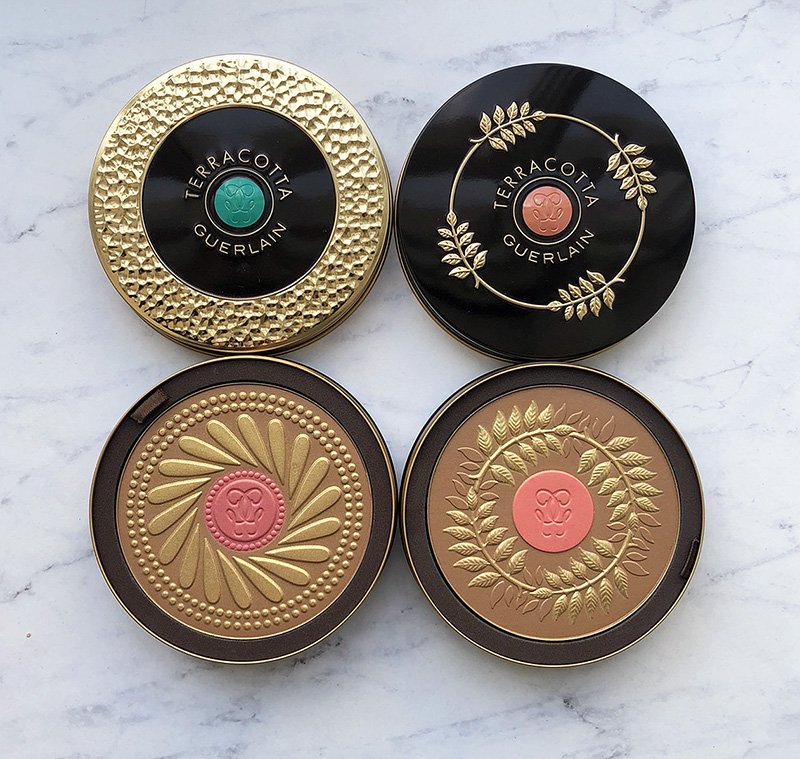
Terracotta Hestia Island and Thalia Island Bronzing and Blush Powders
Guerlain, Summer 2019
For their summer 2019 Terracotta bronzer collection, Guerlain drew inspiration from two Greek goddesses: Hestia, the virgin goddess of the hearth, and Thalia, one of the Three Graces and the muse of poetry. The embossed pattern on the Hestia Island bronzer is reminiscent of those adorning ancient Greek vessels, while the golden laurel leaves of the Thalia Island bronzer resemble the wreaths worn by winners of athletic or poetry competitions.
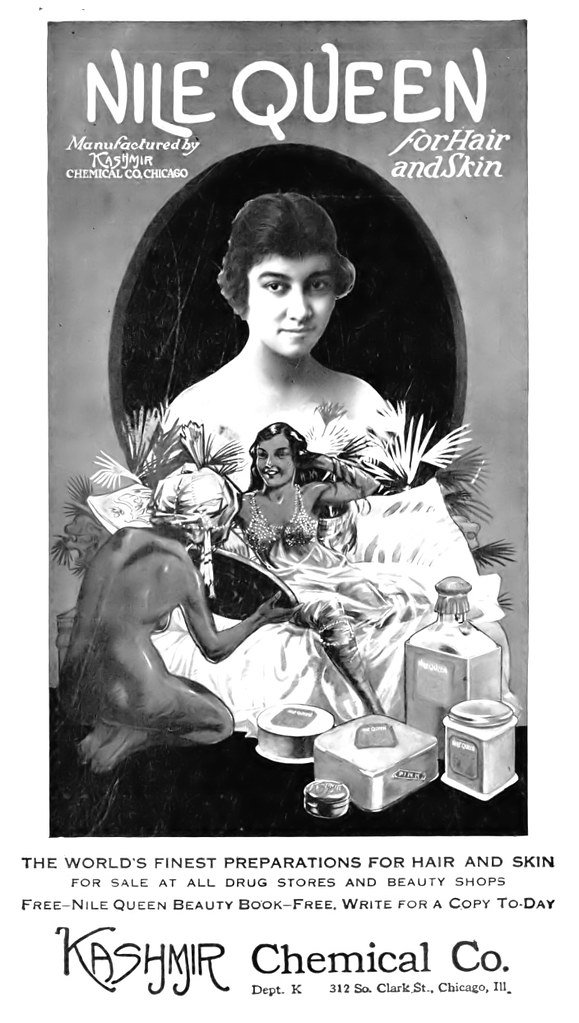
Nile Queen Beauty Preparations Advertisement
Kashmir Chemical Company
1920

Bindi Advertising Tin
Gouri Puja Bindi, ca. 1990s
Kajal Advertising Tin
Murari Bros., ca. 1980s
Gouri Puja Bindi was established in 1990 and still manufactures bindis today. The bindi is a small red dot traditionally worn by Hindu women in the middle of their foreheads to indicate they are married. Today the bindi is also worn for decorative/artistic purposes and a variety of designs and colors are available in sticker form. Per the illustration adorning the sides of the tin, it most likely held packets of multi-colored adhesive bindis. The tin shows a scene from the ancient Indian epic Ramayana, in which Lord Rama and his younger brother Lakshmana worship god of destruction Shiva. Shiva, one of the most powerful deities in the Hindu pantheon, and his consort the goddess Gauri (an incarnation of Parvati) are shown at the top right.
The founding of the Murari Bros. company dates at least to the early 1960s. Kajal, also known as kohl, is the black powder used for eye liner used across much of Southeast Asia and the Middle East. Considered a staple in most Indian households, kajal is primarily worn by women but was sometimes applied to babies as well as protection from evil. An image of Krishna, the blue-skinned 8th incarnation of the deity Vishnu, is displayed on the front of the tin.
The art on both tins is most likely copied from or inspired by old lithographs. Additionally, the depiction of deities is not unique to beauty products; gods and goddesses frequently appeared on Indian advertising tins for confections, tobacco, and spices as well. Like the familiarity of Egyptian, Roman and Greek imagery to European/American audiences, references to divine beings such as Krishna and Shiva are easily recognizable to Indian consumers. While neither of the scenes on the bindi or kajal containers have anything to do with cosmetics, the familiarity of such imagery has wide appeal.
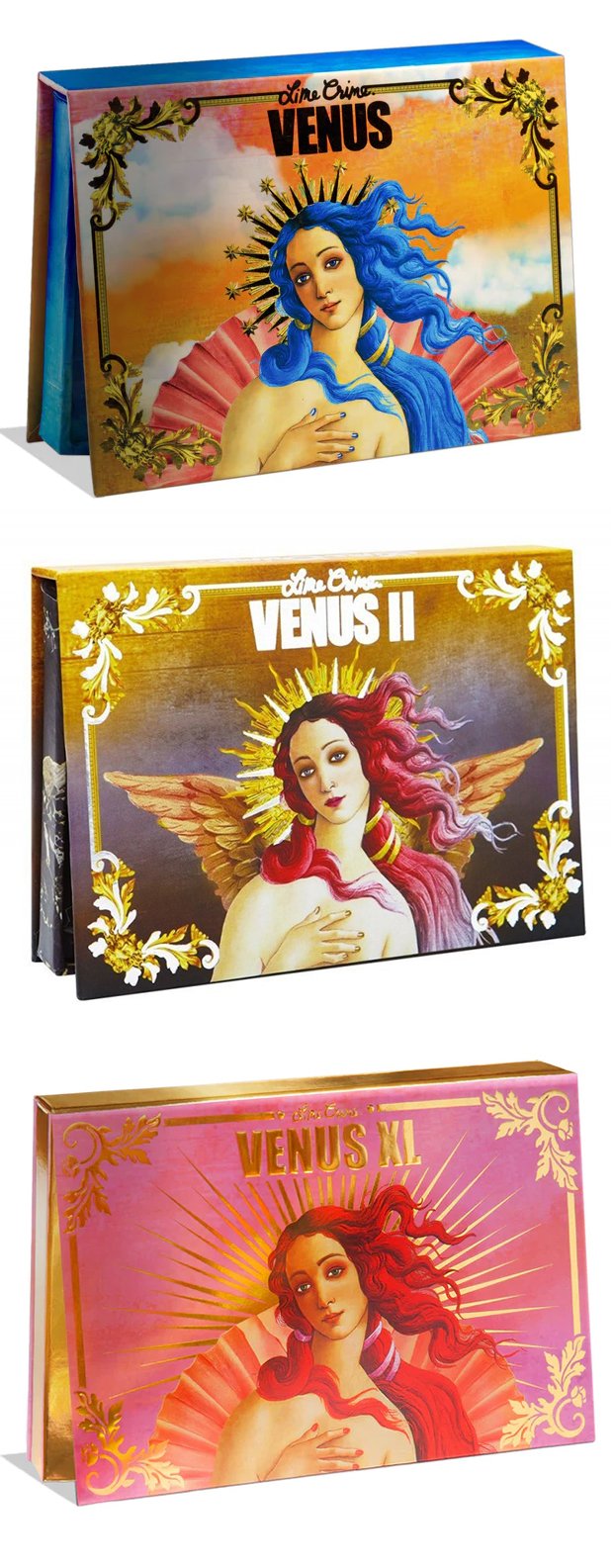
Venus, Venus II and Venus XL Eyeshadow Palettes
Lime Crime, 2015 and 2018

Highlighter and Bronzer
Dolce and Gabbana, Holiday 2014
Fashion designers Dolce and Gabbana re-used the ancient coin motif from their spring 2014 ready-to-wear collection for a highlighter and bronzer later that year. The coins refer to Sicily’s ancient Greek heritage and are a nod to the fashion duo’s Sicilian roots. Specifically, the ΚΑΤΑΝΑΙΩΝ inscription names the city of Catania, one of the Sicilian cities ruled by ancient Greece. Press releases for the makeup collection stated that the profile is of Athena, but the lack of symbols associated with the goddess and the inclusion of a laurel wreath indicate the figure may in fact be Apollo. Although the eight-pointed star is common in ancient coinage, in this context it might represent the sun, another symbol of Apollo.
Image of D & G dress detail from vogue.com; image of ancient coin from arsclassicacoins.com
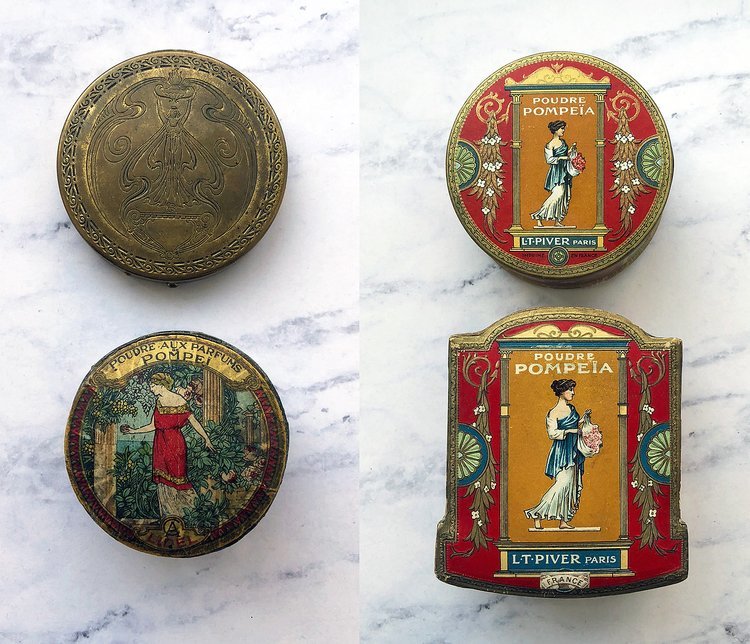
“Votive” Compact
Pompeian Bloom, ca. 1924
Pompei Face Powder Box
Lidel, ca. early 1900s
Pompeia Powder Boxes
L.T. Piver, ca. 1909-1935
The ancient city of Pompeii has been a source of intense fascination for centuries. While the well-preserved site is invaluable to archaeologists and historians, it also proved to be a marketing boon to modern businesses, who harnessed the widespread interest in the city to sell everything from olive oil to shoes. Pompeii’s temples and gardens made ideal themes for cosmetic product names and packaging design. Historic perfume house L.T. Piver introduced their Pompeia fragrance in 1907, with a line of toiletries released shortly after. Pompeia is a chypre floral scent that “symbolizes the luxurious refinements and voluptuous magnificence of ancient Pompeii,” according to a 1923 ad. The design consists of a woman dressed in flowing robes, bearing a bouquet of pink flowers and framed against a background resembling a fresco that possibly portrays Flora. A more Art Nouveau style is reflected in Lidel’s Pompei face powder and one of Pompeian Bloom’s early powder compacts, which feature a goddess-like woman standing in a garden and holding a lamp as a votive offering, respectively.

Eyeshadow palette and lipstick
Uoma Beauty, Summer 2022
When Uoma Beauty founder Sharon Chuter traveled to the Middle East in early 2020, she found herself unsure as to whether she would be able to return to the U.S. as borders began to close due to the pandemic. Feeling the warmth of the sun on her skin helped relieve some of her anxiety. “The sun can be such redemption or rescue in a time of uncertainty. This led me to start researching the sun and spirituality, and I learned more about the ancient Egyptians and their unique relationship to the sun,” she says. The result was the Salute to the Sun collection, which is “a homage to ancient Egypt, and the beauty rituals of its powerful female pharaohs,” according to the Uoma Beauty website. Outfitted in a blue, black and gold color scheme and adorned with a stylized Eye of Horus design, the packaging for the 3 lipsticks in the collection – aptly named Cleopatra, Nefertiti and Hatsheput – recalls a clear summer sky and the luxury of ancient Egyptian palaces. The shade names are also carefully chosen: Khenet, Wahdj, Khesbedj, Nebu and Desher are all colors used in ancient Egyptian art. The concept of channeling ancient Egyptian female rulers via modern makeup is particularly meaningful for a Black woman-owned company and its customers. Uoma Beauty challenges the historic appropriation of Egyptian culture and champions Blackness as beautiful and powerful.
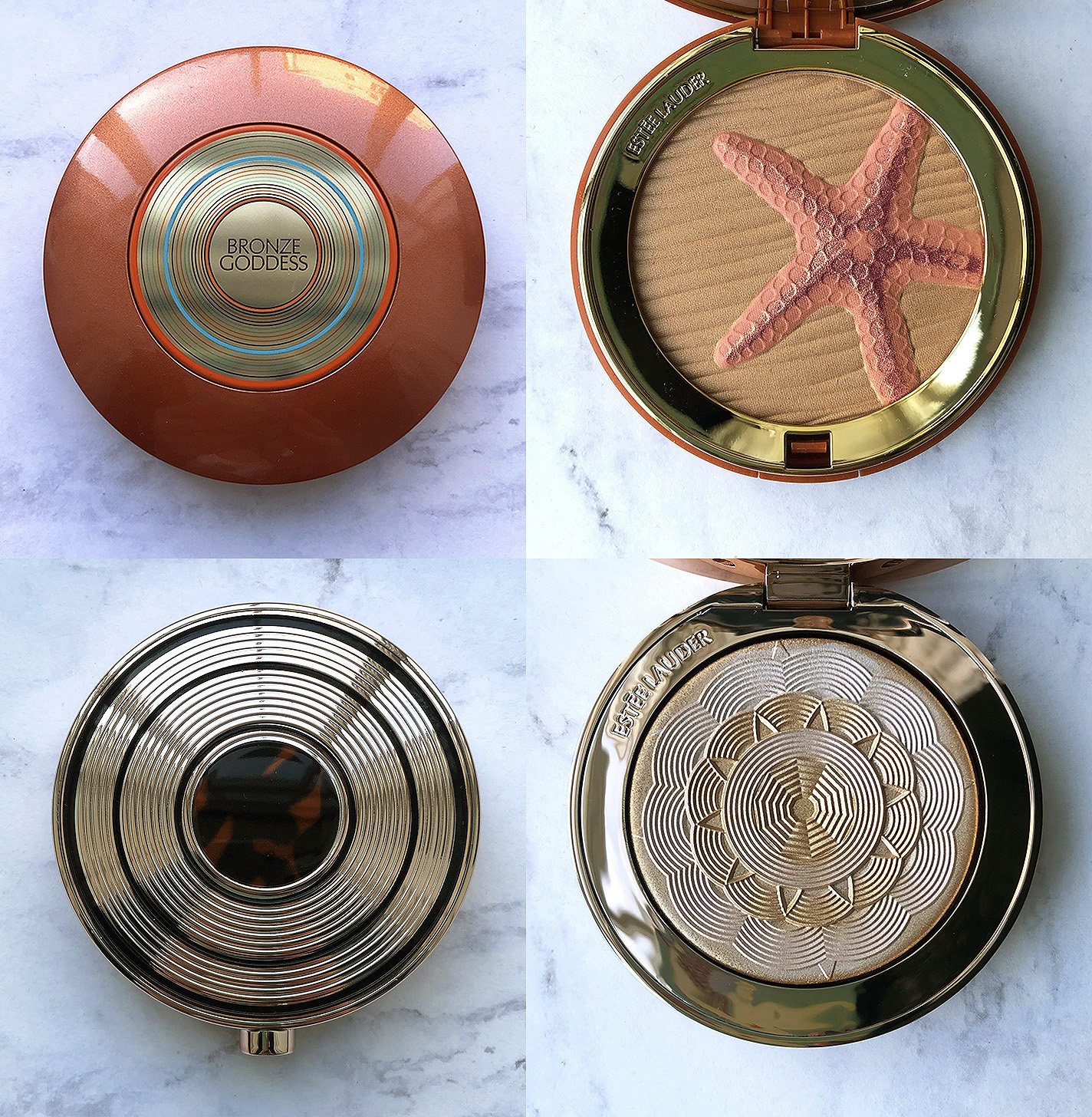
Bronzer Compacts
Estée Lauder, 2011 and 2019

Advertisement
Neige des Cévennes , 1935
Her hairstyle and dress echoing those of the Venus de Milo silhouetted behind her, a woman draped in a sleek gown holds a powder puff and glances at a compact mirror. The stark whiteness of the figure hints at the long-standing Eurocentric glorification of ancient marbles. Combined with the copy, which assures the wearer that the powder will provide the “dazzling radiance of the virginal purity of snow,” the ad presents white skin as a pillar of ideal beauty and suggests that skin tone is indicative of moral virtue.

Splendours Bronzing Compact
Clarins, Summer 2013
“Sunshine into gold. Travel to faraway lands, to the heart of an ancient people…and discover the splendours of a pre-Columbian civilization that worshiped the sun.” While the ad copy for Clarins’ Splendours bronzer does not specify any particular pre-Columbian culture, most likely the marketing team was looking at an ancient Aztec sun stone. The design similarities are multiple: The circle in the center surrounded by four square shapes is found in each, along with the concentric triangle at the top of the center circle and the four dots placed around the squares and one at the bottom of the inner circle. The tiny horseshoe-like pattern appears throughout both as well. The triangles with the scrolled edges in the stone find themselves in the outer case of the palette and are also present in the powder, albeit slightly deconstructed there (the triangle is broken up into its base shape with two scrolls on each side). Additionally, the stone is actually believed to be an altar or ceremonial container for the sun god Tonatiuh rather than a calendar, making Clarins’ choice of inspiration appropriate. While the compact presents an aesthetically pleasing design, the accompanying text unfortunately points to exotification and “othering” of an indigenous culture.
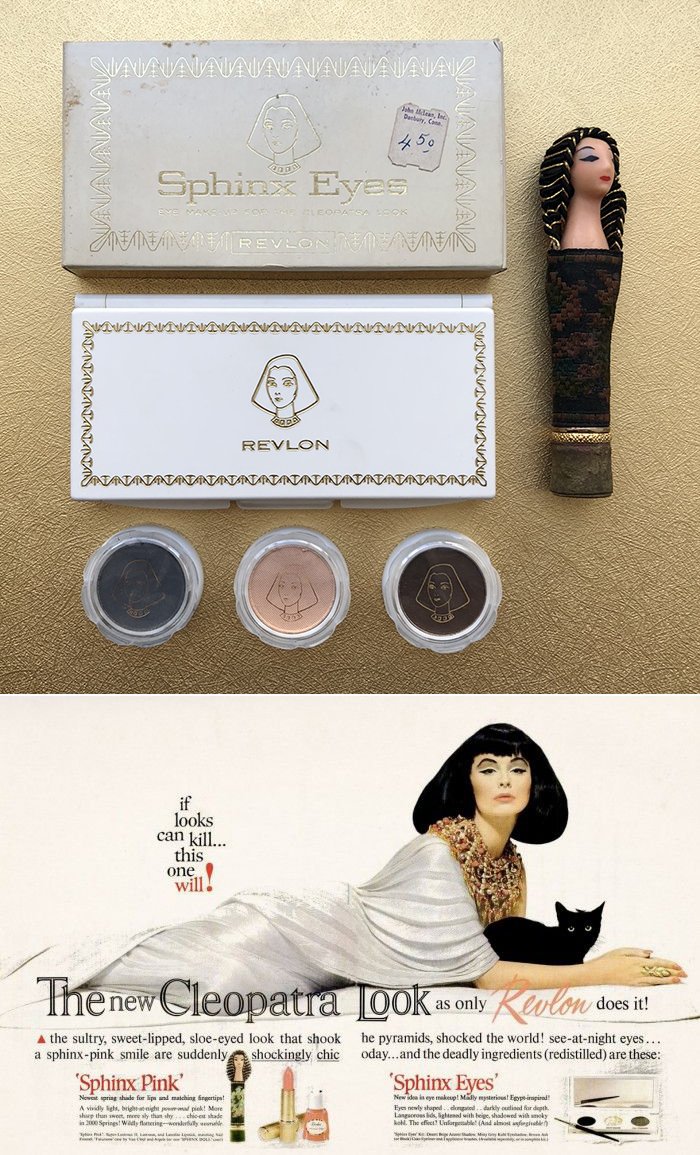
Sphinx Eyeshadows, Liner, Doll Lipstick Case and Advertisement
Revlon, 1962
Nowhere in the cosmetics world is the seductive appeal conferred upon Cleopatra by the Western imagination more obvious than in Revlon’s Sphinx collection, intended as a tie-in to the 1963 film Cleopatra starring Elizabeth Taylor. In this fantasy, Cleopatra’s bewitching nature is presented as dangerous, even deadly, while suggesting that such powerful allure can be within the grasp of the average woman via makeup.
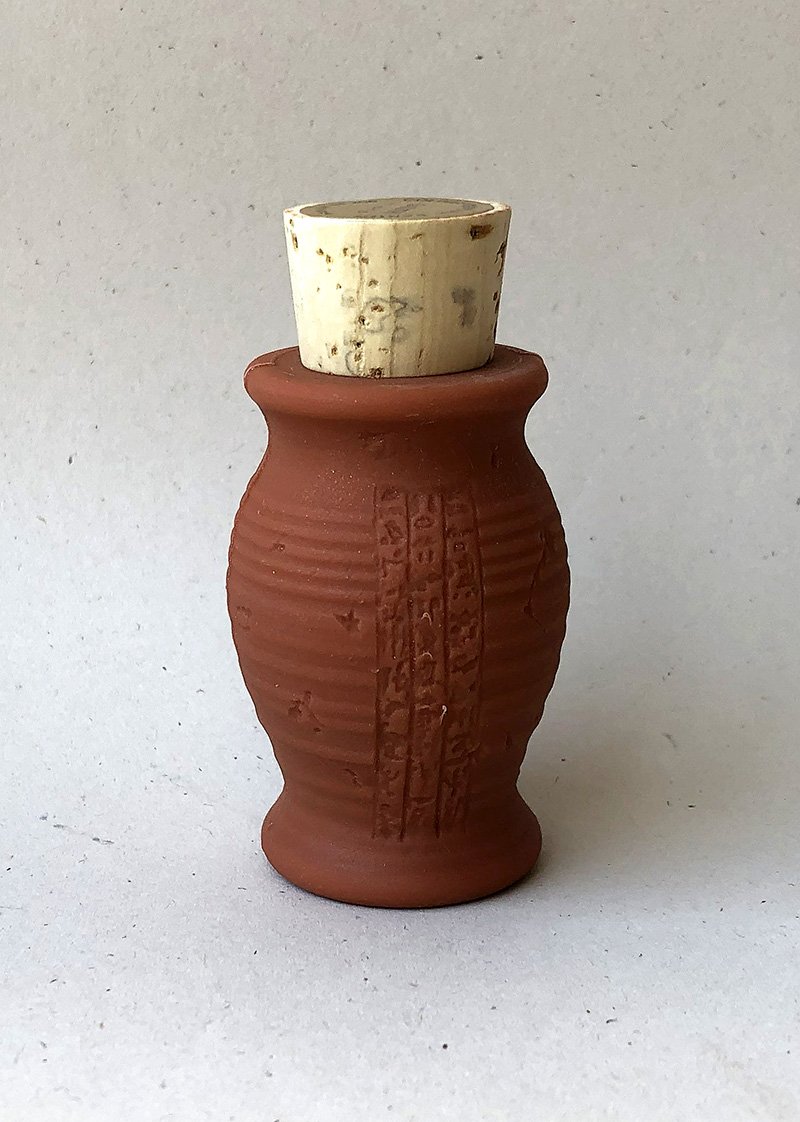
Egyptian Earth Powder
Colora
Originally introduced in 1981 by Chicago company Classic Laboratories, Egyptian Earth is intended as a multi-use product made primarily from iron oxides. Much like its predecessor Indian Earth, marketing for Egyptian Earth relied on exotification and the notion of sharing beauty knowledge that was hidden up to now. The container was allegedly created by an Atlanta-based potter, who was commissioned to make several miniature clay pots with “an Egyptian look” per Classic Laboratories’ request. While an expert in Egyptian antiquities proposed that the container was a replica of a canopic jar, the firm’s vice president at the time, Dottie Smith, claimed that the resemblance to these ancient Egyptian funerary urns was pure coincidence: “We selected an urn with an Egyptian look that ties into our name, Egyptian Earth…we did not take a [canopic] jar knowing that and copy it. No one has ever said anything negative [about the packaging].”* The faux hieroglyphics on the container set Egyptian Earth apart from Indian Earth and several copycat products released by other companies; however, the packaging for all of them adheres to a standard design of a plainly-shaped clay-like pot and cork stopper. This was most likely due not just to apathy but to emphasize the natural mineral ingredients and foster a sense of awe, as if the wearer had unearthed a centuries-old relic.
*The South Bend Tribune, July 20, 1982

Nubian I and Royal Eyeshadow Palettes
Juvia’s Place, 2016 and 2020
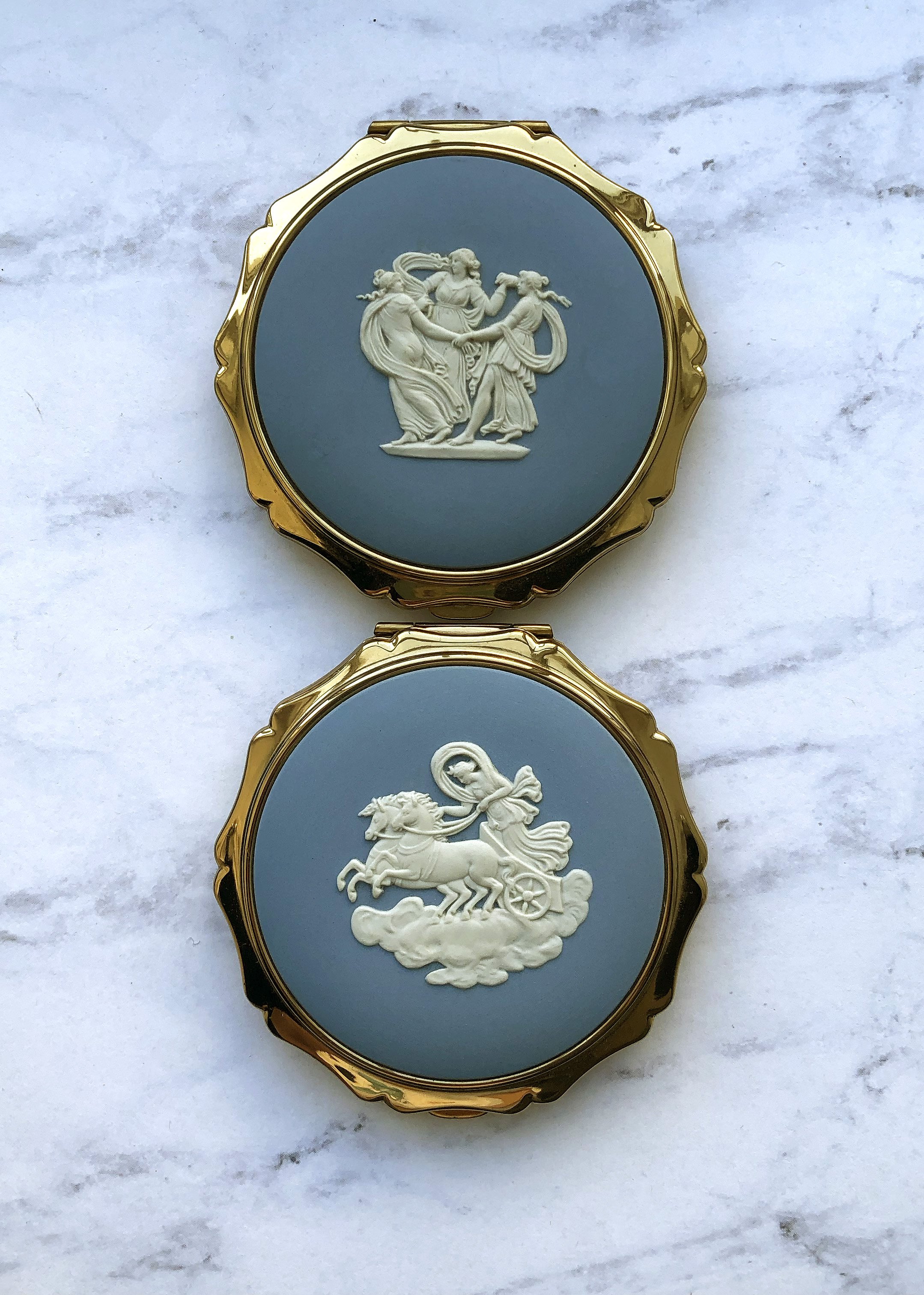
Wedgwood Compacts
Stratton, late 1960s-early 1970s
British compact manufacturer Stratton collaborated with the historic Wedgwood company for a series of compacts and other cosmetic accessories in the late 1960s. Using the original Neoclassical designs of Josiah Wedgwood, the compacts feature various mythological figures such as the Three Graces and Aurora driving a chariot.

Eyeshadow Palettes and Lipstick Set
Zeesea, 2019
In 2016 the British Museum began a partnership with Chinese licensing agent Alfilo Brands to sell a variety of merchandise inspired by the museum’s collections. By 2018 Alfilo had developed over 500 British Museum branded products, making the museum’s licensing program the largest in the cultural institution sector in China with earnings of nearly $30 million that year and projected profits of $51 million in 2019. Makeup was just one of many product categories to take advantage of the licensing arrangement, and emerging Chinese brand Zeesea saw an opportunity to raise their visibility using both the British Museum name and designs inspired by its vast Egyptian collection. With eyeshadow palettes named for specific objects in the British Museum and lipsticks with hieroglyphics carved into them, Zeesea’s Enchanting Egypt collection put them on the radar of Chinese and international consumers alike. The palettes shown here are based on the Gayer Anderson cat sculpture representing the goddess Bastet and a figure from the Great Harris papyrus. These artifacts were acquired as an indirect result of colonialism, thereby adding a more insidious layer of appropriation.

“Italian Touch” Advertisement and Store Display
Max Factor, 1957
An ancient statue, based on the famous Augustus of Prima Porta, is transfixed by model Virna Lisi as the Colosseum looms in the background. The advertising for Max Factor’s Italian Touch collection combines the grandeur of the Roman empire with the city’s post-war status as a fashionable, cosmopolitan city.
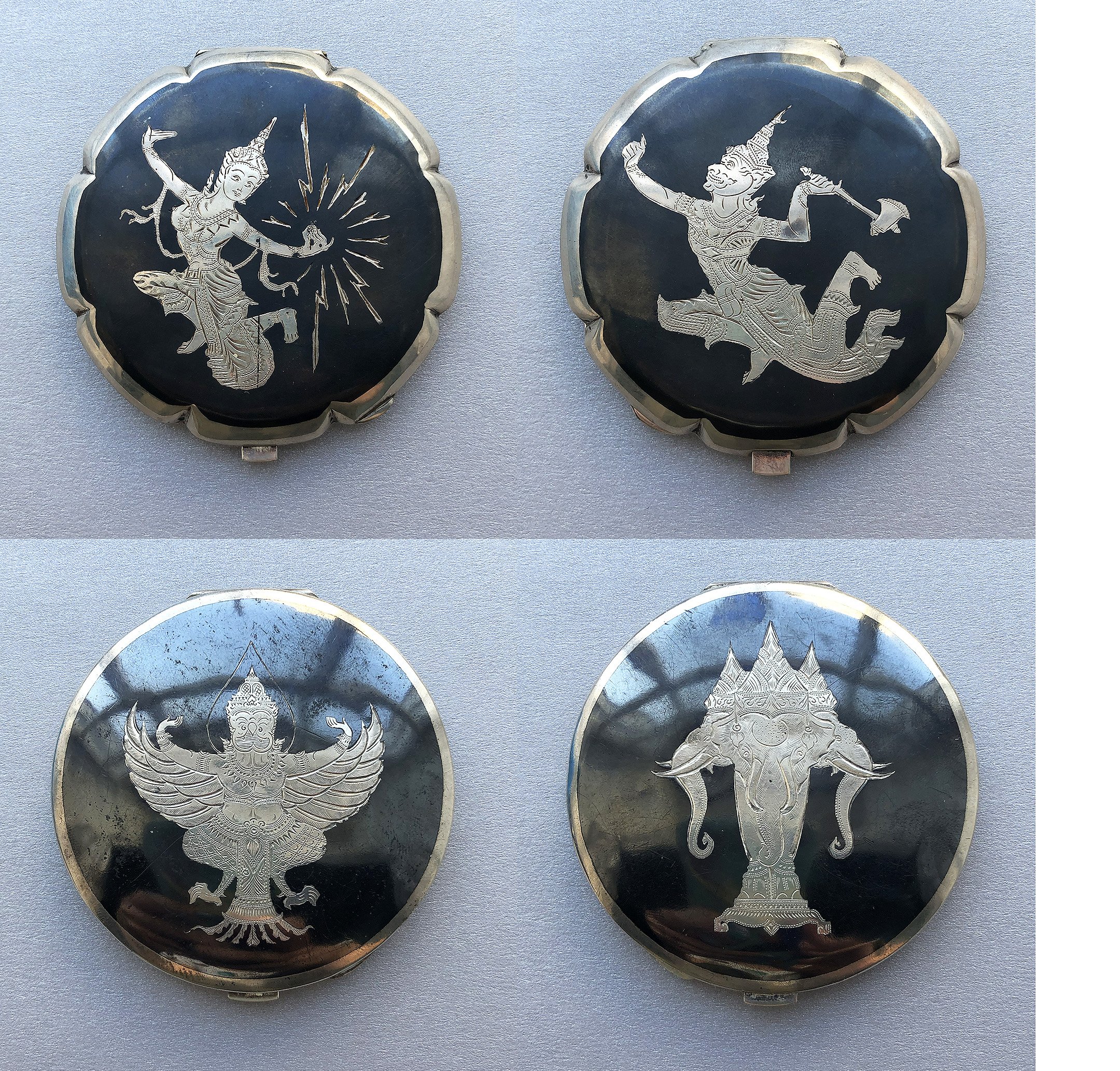
Nielloware Compacts
1940s-1970s
Nielloware is a metalwork craft made by carving a design into a silver background and adding niello, a black-colored metal alloy, to fill in the negative space around the design. Nielloware has been a part of Thailand’s cultural heritage since the 1400s, but became especially popular for tourists traveling in Thailand from the 1930s-1970s. Nielloware frequently depicts figures from ancient East Asian folklore and mythology. The most common ones include Garuda, a half-god, half-eagle creature who carries the Hindu god Vishnu; Airavata, a three-headed white elephant who carries god of rain Indra; and the goddess of lightning and god of thunder, Mekhala and Ramasoon.
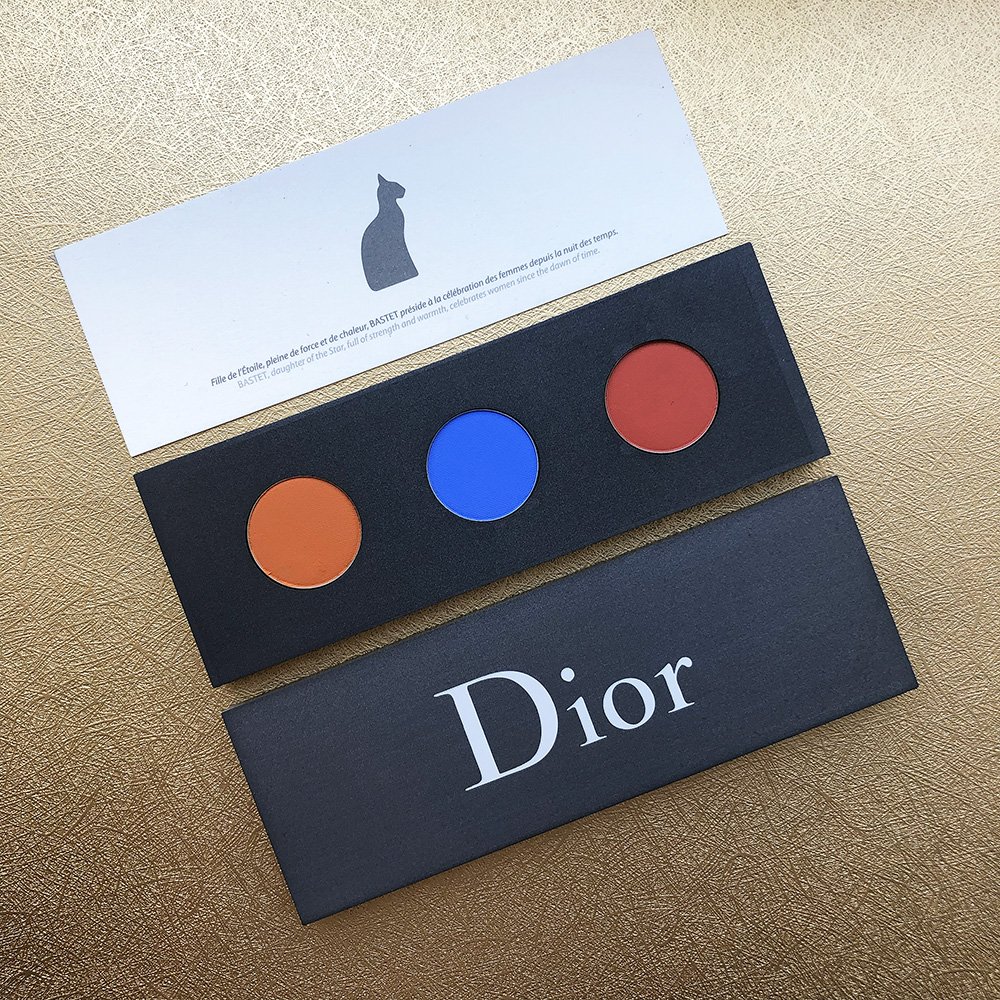
Les Tablettes de Bastet Palette
Dior, 2013
The house of Dior enlisted French painter and sculptor Vincent Beaurin to extend his previous work inspired by the Egyptian deity Bastet, as well as the artist’s “Spots” series, to design an eyeshadow palette. Bastet, sometimes depicted as a woman with the head of a cat, was the goddess of music, dance, and feasting. Beaurin wanted to create a palette that resembled Egyptian cosmetic containers, “like a very ancient stone object that bears the traces of myth and ancestral practice.” The palette consists of two magnetized stone slabs in Dior’s signature Trianon grey, whose neutral tone, Beaurin states, “helps to optimize the way we observe colours, their radiance, and their persistence when they disappear and their reactions when you put them together.” The artist’s choice of the word “tablet” was deliberate, as he believes the term “establishes a link between writing, memory and ancient objects, often made of schist, on which people crushed pigments to produce eye make-up.” The round shape for the colors was chosen so that they would be better suited to use of the palette. “Each colour is a fullness in itself. In a way, each colour is a world, a planet. Similarly, our eyes are round. The circle is a full shape. It recurs often in my work, perhaps precisely because it involves abstraction, going beyond form. Something round also seems better adapted to the touch than something angular.” The shade names and arrangement incorporate Beaurin’s interest in tying modern makeup to aspects he associates with ancient Egypt, as well as his desire to elevate makeup application to a spiritual practice. “The repetition of the S, the initial letter of the name of each colour, gives pace to the way the words are uttered, Saffron Sapphire Silex. This pace is part of the dynamics, of the relations occurring between the elements making up the landscape. I also like S for its design, two inverted spirals, an unfinished 8, and for its phonetics, the phonetics of silence...this object is also a vehicle, an instrument of sight and projection and--why not?—a sort of Egyptian prism. The Bastet tablets are a sort of arrangement, where three disks of monochrome colour are in a way in orbit with each other. They are as if in mid-air and their encounter is waiting for desire and the intervention of the person whose eyelids will be the ideal surface for mixing them.”

Eyeshadow Palette
Beautaniq Beauty, Fall 2020
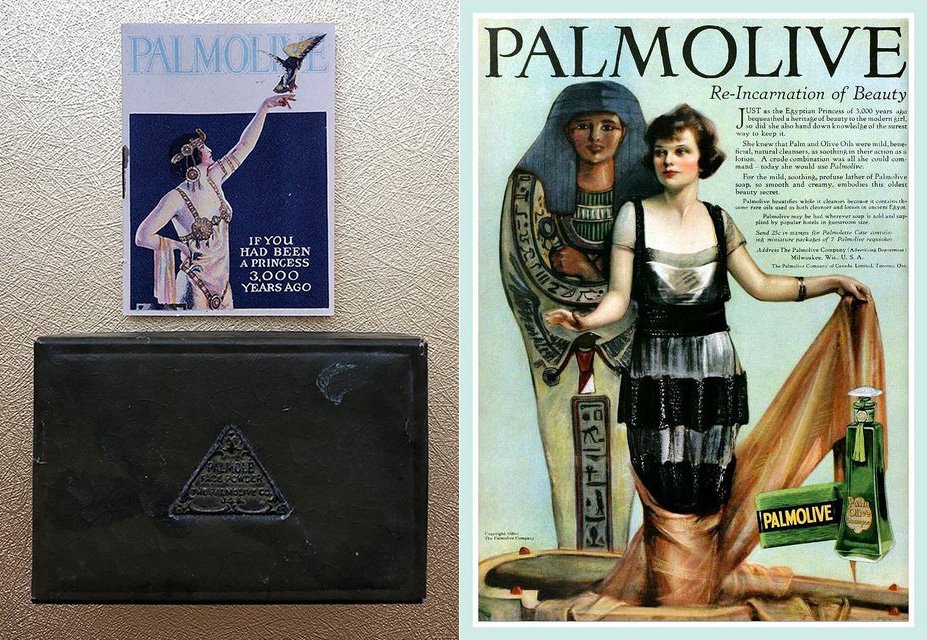
Powder box and advertisement
Palmolive, 1920
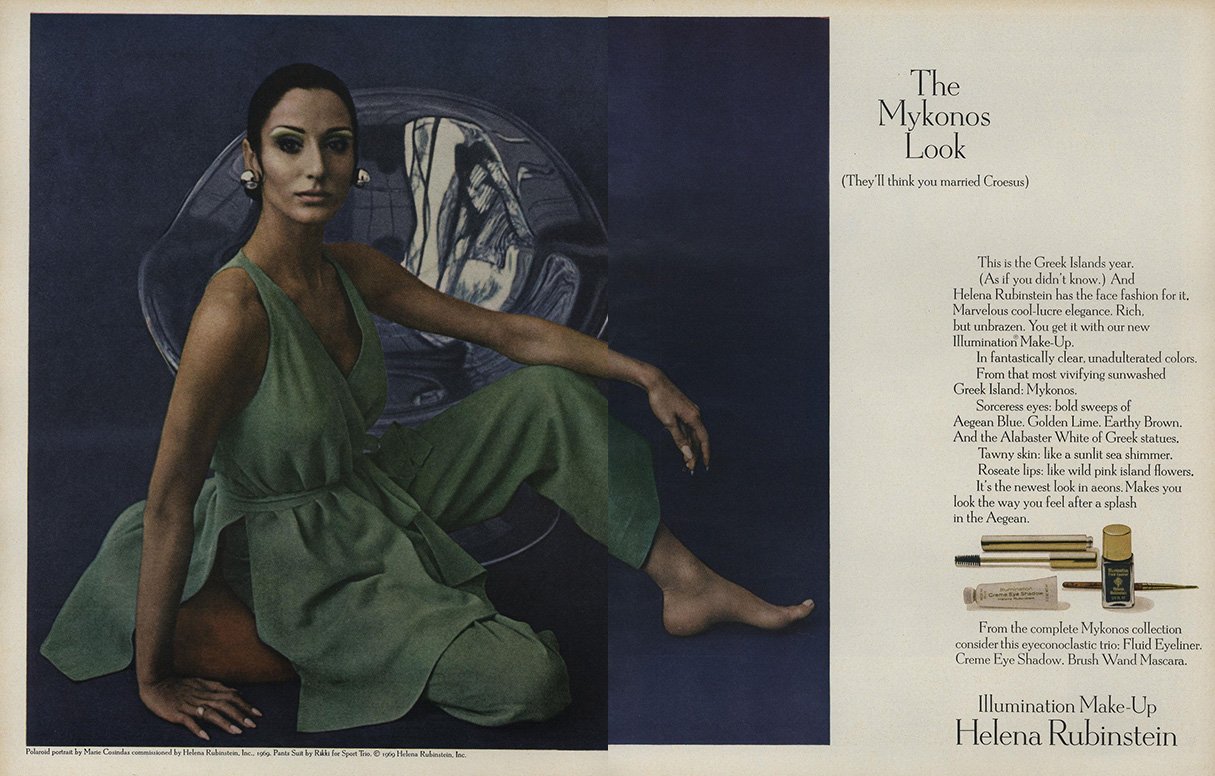
Advertisement
Helena Rubinstein, 1969
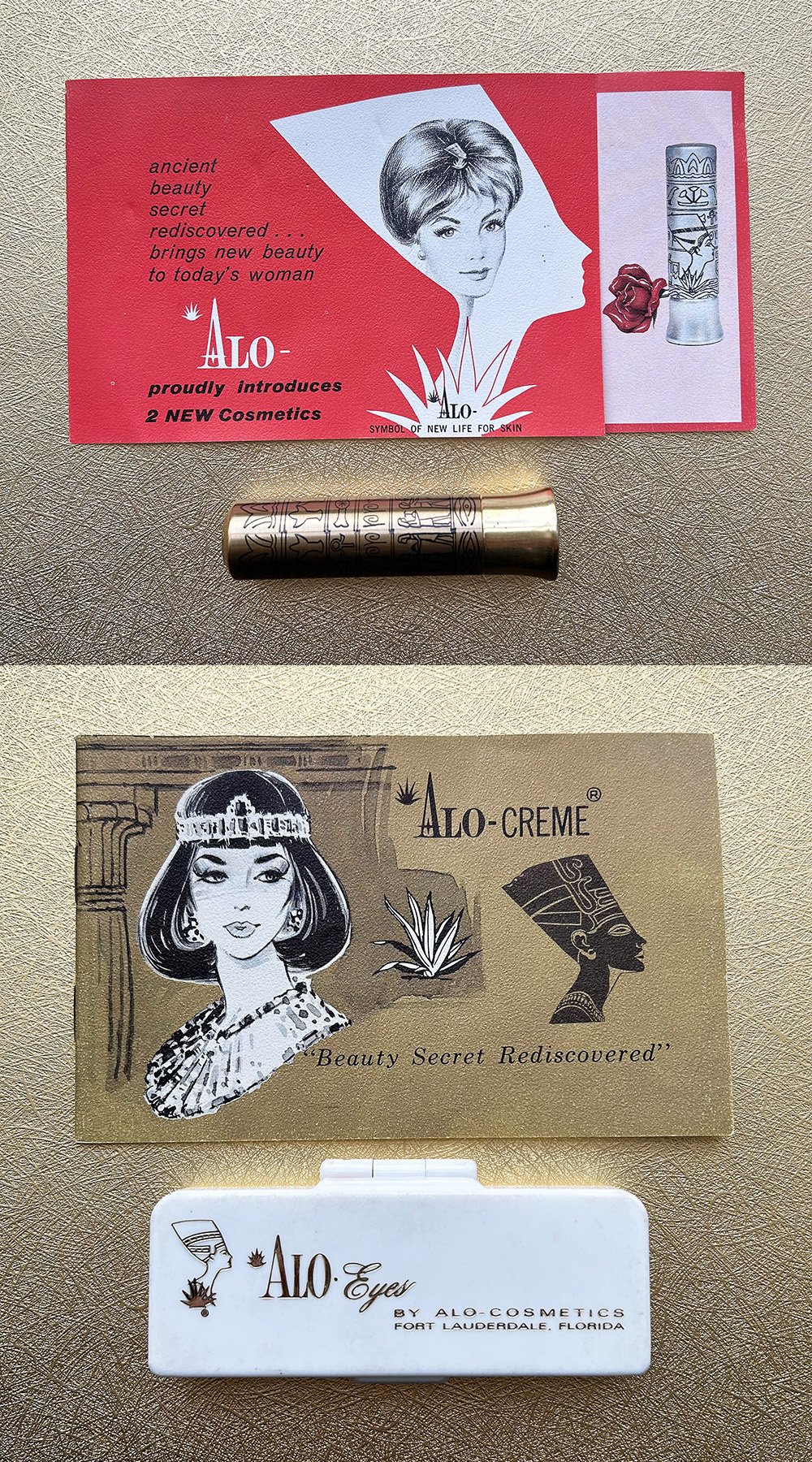
Brochures, Lipstick and Eyeshadow
Alo Cosmetics
Ca. 1960s
While aloe vera was used in commercially available skincare since the 1950s, Alo was possibly the first brand to infuse color cosmetics with the ingredient. Aloe Crème Laboratories was founded in 1953 by Rodney Stockton, a businessman who stumbled across the aloe plant’s healing abilities while seeking relief for a sunburn he suffered on a vacation in Florida. Originally Stockton had Cleopatra in mind as Alo’s symbol, but ultimately chose Nefertiti following the release of the 1963 film Cleopatra, as he believed the “scandalous behavior” of the movie’s stars Elizabeth Taylor and Richard Burton would negatively impact the public’s perception of the brand.*
*Carol Westlake, “Written in the Stars,” Palm Beach Life, December 1968, 40.
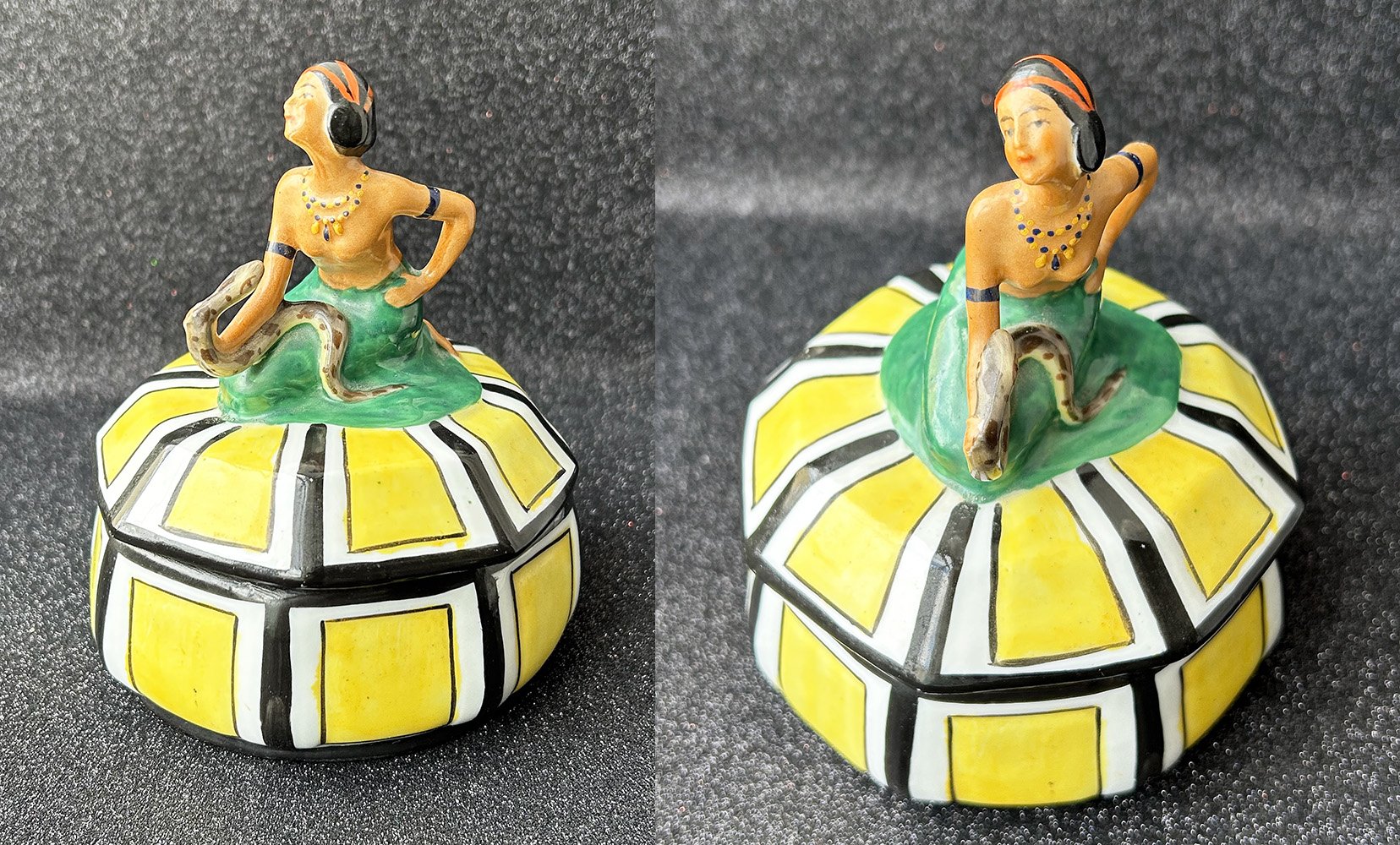
Powder Box
Ca. 1920s
This German-made, porcelain powder box features a seated dark-haired woman holding a snake. The color of her skin is noticeably darker than in other examples of figural powder boxes of the era. The woman’s identity remains a mystery; while she may be interpreted as Cleopatra due to the inclusion of a snake (possibly an asp, based on the markings), her skin color points to non-royal status, suggesting that she may be a snake charmer.
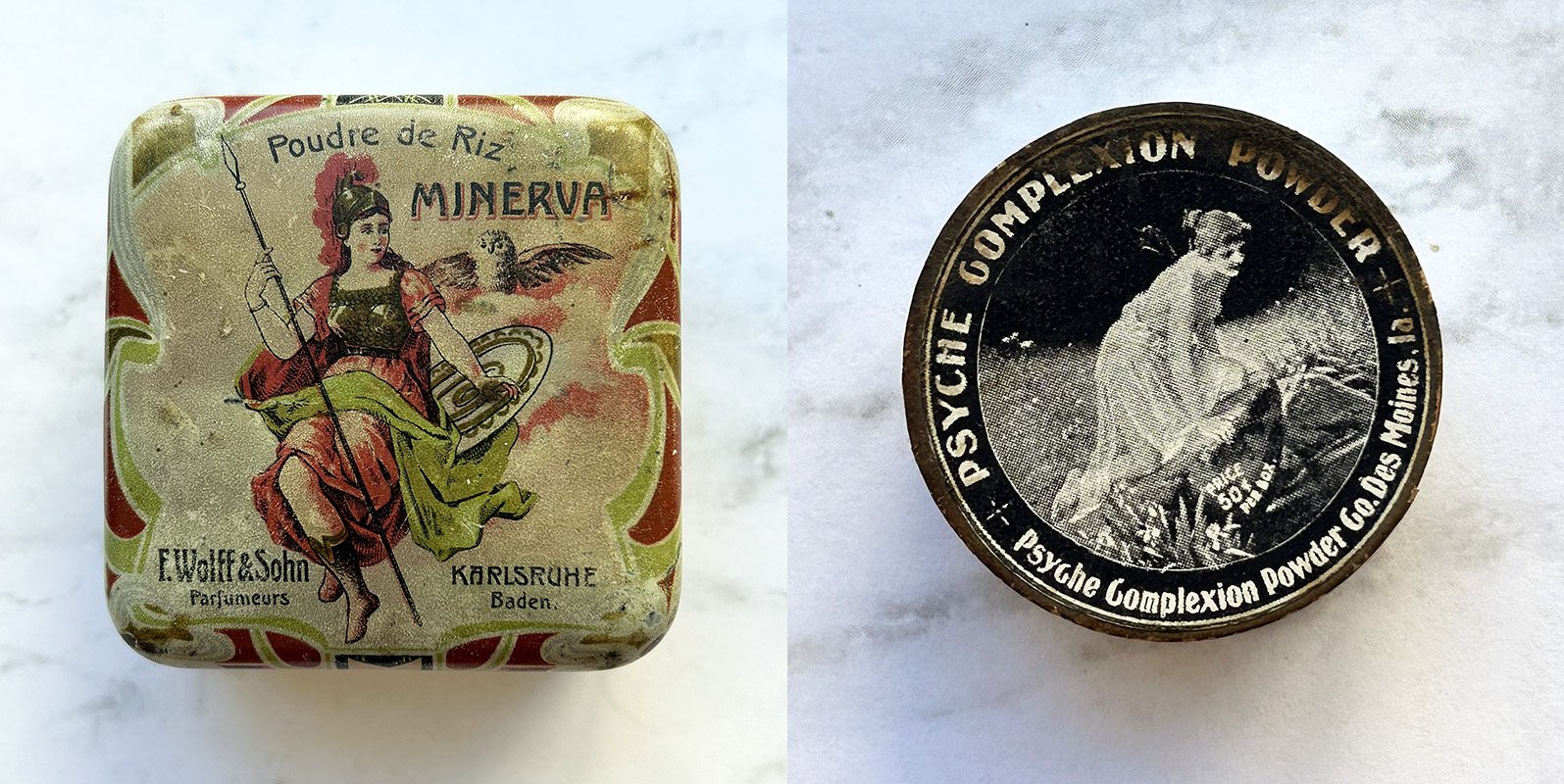
Minerva Poudre de Riz
F. Wolffe & Sohn
1920s-1930s
Psyche Complexion Powder
ca. 1894-1907
In addition to Artemis/Diana, ancient Greco-Roman figures other than Venus/Aphrodite sometimes appear on makeup packaging. F. Wolffe & Sohn’s face powder depicts the Roman goddess of wisdom Minerva triumphantly brandishing a spear and shield and accompanied by her symbol of the owl, perhaps suggesting that intelligence is a form of beauty. Psyche Complexion Powder shows the goddess, hair upswept in the Edwardian style named for her, wearing a sheer flowing gown perched on some rocks in a lush meadow. The myth of Psyche lends itself well to makeup packaging: Psyche’s beauty allegedly rivaled that of Aphrodite, and her symbol of the butterfly is an apt reference to the visual metamorphosis that makeup can offer. Using the figure of Psyche may also allude to the inner beauty of the soul.
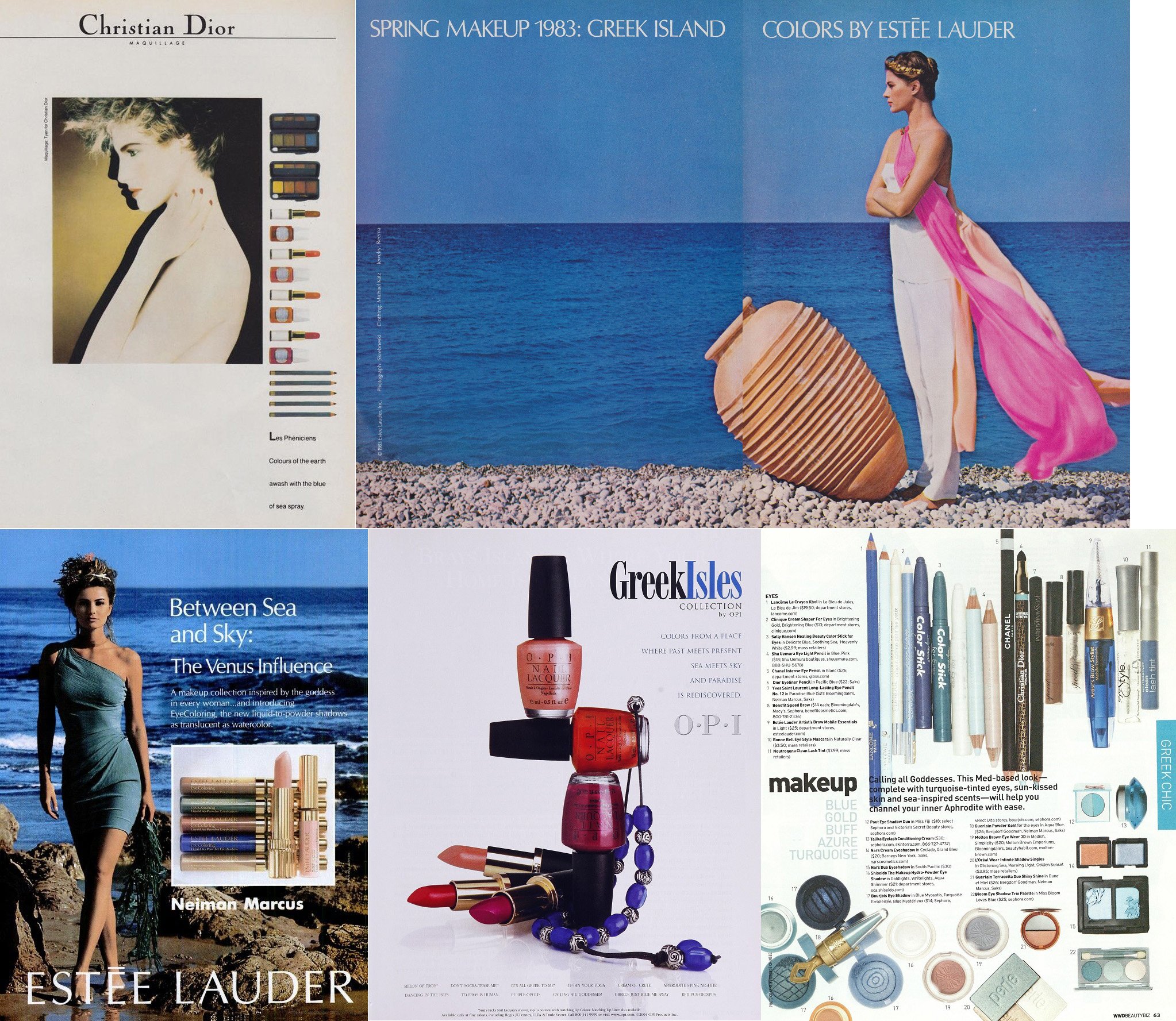
Advertisements: Dior, Spring 1983; Estée Lauder Spring 1983 and Spring 1992; OPI, Spring 2004; Women’s Wear Daily, March 2005
The geography of Greece serves as inspiration for a number of seasonal color stories focused on beige tones and shades of blue. Referencing its early civilizations, sandy beaches and the clear blue of both the sky and the Mediterranean Sea, these ads portray Greece as an idyllic paradise and associate the physical beauty of the land with that of ancient goddesses.





































Egyptian Style Face Powder
Marietta Stanley, ca. 1906-1925
Nyalis Face Powder
Nyal Company, ca. 1919-1926
Velvetina Egypta Face Powder
Goodrich Drug Company, ca. 1917-1930
Ancient Egypt’s appeal was harnessed by cosmetic companies well over a decade before the opening of King Tut’s tomb in 1922 and the ensuing wave of Egyptomania, particularly in design. Nyal’s Nyalis powder box features a sphinx stonily gazing out of a triangle set in the center of the box, flanked by an ornate gold and blue lotus flower pattern. Like most face powders of the early 1900s, Velvetina’s Egypta was part of a larger toiletries line intended to accompany the brand’s Egypta fragrance. While the powder and other items were introduced in 1915, in 1917 the company released a new box for the face powder: a “beautiful new style Oriental design bronze green and straw colored boxes,” according to one ad. In the center a silhouette of a woman’s head shows a crown with an uraeus, the stylized, rearing cobra that symbolized divine authority and is associated with the goddess Wadjet. Marietta Stanley’s Egyptian face powder box features an illustration of a woman wearing an elaborate floral headdress with a faint outline of pyramids in the background.
Milano Compact
Kanebo, Holiday 1993
Beginning in 1991, each holiday season Japanese company Kanebo releases ornately designed compacts featuring goddess-like figures whose draping and poses referencing allegorical paintings of the Neoclassical era. With a seashell throne, flying putti, and the goddess's raised arm, the scene depicted in the 1993 compact appears to reference several 17th and early 18th century paintings, namely Simon Vouet's The Triumph of Amphitrite, Michele Rocca's The Triumph of Venus, and Paolo Matteis's The Triumph of Galatea.
For more information, see the Makeup Museum’s article on Kanebo’s holiday compacts.
Image via Wikimedia Commons
Compact
Rex, ca. 1940s
Matched Makeup Kit and Powder Box
Woodbury, ca. 1941-1947 and 1948-1954
The Woodbury Company changed its packaging frequently throughout its 100-year history and began incorporating goddess imagery in the early 1930s. According to Modern Packaging, in 1948 Woodbury completed an in-depth marketing study, working with advertising agency Robert W. Orr and Associates and surveying over 2,000 people. The company determined the goddess logo was too generic, and the Greek key pattern especially was getting stale due to its ubiquity. “The key motif, through wide usage for decoration in other fields to suggest classic beauty, had also lost much of its distinctiveness and identity.” Three new designs were offered, including an illustration of Venus standing atop a shell and surrounded by delicate pink blooms, which directly referenced Botticelli’s The Birth of Venus. This design was ultimately selected despite not being the first choice among survey participants, as the company felt the Venus and flower combination was both modern and timeless: “[The Venus design], it was decided, had the basic elements of style and good taste regardless of temporary fashion trends. Here could be a goddess of beauty as a flesh and blood symbol of all Woodbury beauty products – a great advance over the cold abstract figure used on the previous Woodbury powder box. With the striking, modernized Venus theme were incorporated delicate pastel flowers as an incidental part of the design, thus combining the long-known foolproof motif in cosmetic packaging with a new identifying symbol, but overcoming any objections to a purely floral design.” Venus’s status as the epitome of physical beauty and femininity became directly tied to Woodbury’s products, following a long tradition of this depiction in Western art.
Modern Packaging, July 1948, p. 85-89.
Floral Engraving Odey Makeup Palette
Florasis, 2021
Florasis was founded in 2017 and incorporates traditional Chinese art and culture across their entire product line. This palette features scenes from the poem “The Nymph of the Luo River”. The poem was written by Cao Zhi (192-232 CE) and painted on a massive scroll originally by Gu Kaizhi (ca. 344-406 CE). Cao Zhi tells a tale of visiting the Luo river with his servants and his brief, ultimately unsuccessful love affair with a beautiful nymph/goddess. The palette’s concept connects ancient and modern beauty ideals, while the ad copy emphasizes the idea of transformation from human to divine being: “We’d like you to meet our most intricate palette yet, a truly seamless and multifunctional product to enhance the goddess in every woman.”
For more on Florasis, see the Makeup Museum’s article.
Egyptian Adventures Blushes
JudyDoll, 2020
Like fellow Chinese brand Zeesea, newcomer JudyDoll took advantage of the licensing available from the British Museum to use the institution’s name and motifs inspired by its Egyptian artifacts on a makeup collection. Unlike Zeesea, however, JudyDoll injected a more playful vibe by incorporating a Hello Kitty license as well. The result is a charming mishmash of references and styles that appeals to a wide audience, albeit far removed from ancient Egyptian history.
Eyeshadow Quad
Elizabeth Arden, Fall 2006
The Sueded Browns quad was part of a collection consisting of 3 eyeshadow palettes featuring a vignette from “A Pageant of Beauty”, a 70-ft-long, 14-panel mural commissioned by Elizabeth Arden in 1935. Painted by prominent American artist Clara Fargo Thomas, the mural “embodied the story of woman’s insistence on loveliness throughout the ages,” according to Ralph Flint, author of the mural’s guidebook. Here Nefertiti, surrounded by her beauty accoutrements and servants, gazes into a mirror to touch up her lip color. It should be noted that the “caricature found on a papyrus in the Turin Museum” on which the queen’s pose is based refers to a scroll depicting prostitutes preparing for their clients. Thomas may have been slyly commenting on the long-held notion that makeup was the domain of sex workers and not “respectable” women, which persisted in the 1930s despite the efforts of large companies such as Arden to make cosmetics socially acceptable.
Catalog
Benefit Cosmetics, 2007
The vintage mannequins used by Benefit as their unofficial mascots received a goddess makeover for the company’s summer 2007 catalog. Founders Jean and Jane Ford allude to their products’ transformational ability that turns the average woman into a divine being. By using Benefit, customers can shed the banality that comes with being mortal without also losing their humanity. “All we know is that from time to time it’s wonderful to feel like a goddess, to look like a goddess and be told, ‘You’re a goddess.’ We are the goddesses of makeup, always mixing up new magic for your face and body…goddesses aren’t real, but we are. We get zits, have jobs, do laundry, stroll our babies and blow kisses to our significant others. We like being human. If you’re created in stone, it’s really hard to crack a smile.”
Powder Compact
L’Peggie, 1926-1933
Face Powder
Artemis, 1925-1926
“Enchanted Forest” Compact
Max Factor, ca. 1973-1976
Lipstick Tissues
Kleenex, ca. 1937-1940
The goddess of the hunt, Artemis (or the Roman version Diana), appears to be the second most referenced goddess behind Aphrodite/Venus in makeup advertising. In contrast to the sensual beauty and vanity associated with the goddess of love, Artemis symbolizes bodily freedom and humanity’s bond with the natural world. Whether draped in flowing robes or tastefully nude, as a stylized warrior or enjoying the forest with her hunting dogs and arrow, the figure of Artemis offers an alternative to traditional beauty signifiers by linking classical ideals to strength and lack of artifice.
Advertisements
Germaine Monteil, 1944
Cutex, 1961
Ancient Greek and Aztec cultures are treated very differently in ads by Germaine Monteil and Cutex. Greece is held in the highest regard (one of the “civilizations most noted for their achievements”), while the Aztecs are referred to as “primitive”. Additionally, the Chac Mool sculpture which the models use as a mere prop to show off their manicures is from the ancient Mayan site of Chichen Izta.
Real Girl Hieroglyphics Paint Kit and Advertisement
Tussy, 1968
Wanting to capitalize on the body painting fad embraced by hippies, in the summer of 1968 Tussy released a makeup kit containing 5 colors, brush, stencils and a how-to guide. It’s unclear as to why a reference to ancient Egypt was used (besides garden variety exotification and cultural appropriation that was typical at the time), but Women’s Wear Daily offered this questionable explanation: “Women are a mystery anyway, so hieroglyphics are a natural for them. Tussy, which has a thing for Egyptians, has come through with a new version of the old hieroglyphics idea...the stencils come in interesting shapes like an anchor, a question mark, a butterfly and a violin - all of these must have some meaning that only the old Egyptians know about.” Other ads encouraged users to be creative and convey their personality or current mood through various designs (akin to beauty patches), emphasizing that the kit was intended for youthful, adventurous types.
"The Cosmetics: The Beauty Part." Women’s Wear Daily, vol. 116, no. 127, Jun 28, 1968, pp. 14. ProQuest, https://www.proquest.com/magazines/cosmetics-beauty-part/docview/1565179787/se-2.
Poudre Egyptienne Compact and Advertisement
Ramses Paris, 1923
The Ramses brand was founded in 1919 in Paris and selected Le Blume Import Company to distribute the line in the U.S. in 1921. By 1923 ads for the powder boxes and compacts were appearing in Vogue magazine. The ad copy is pure nonsense: neither the perfumes nor the powders were produced in Egypt. However, the introduction of the brand in the U.S. at that time was fortuitous, as the opening of King Tut’s tomb a year later fueled a craze for any goods that referenced ancient Egypt.
The Ramses compact was made by the Bristol, CT-based Zinn Corporation, a company that produced some of the earliest and most memorable compacts in the U.S. While the powder was scented with the “Secret du Sphinx” fragrance, the compact itself shows a woman rather than the mythical creature. The design shows a woman in profile, holding a perfume bottle in one hand and a flower in the other, which she brings to her nose to enjoy its scent. The pyramids of Giza are just barely visible in the background, while lotus flowers on each side towards the lower third of the compact bloom into an arc of leaves.
Ad image from the Vogue archive
Terracotta Hestia Island and Thalia Island Bronzing and Blush Powders
Guerlain, Summer 2019
For their summer 2019 Terracotta bronzer collection, Guerlain drew inspiration from two Greek goddesses: Hestia, the virgin goddess of the hearth, and Thalia, one of the Three Graces and the muse of poetry. The embossed pattern on the Hestia Island bronzer is reminiscent of those adorning ancient Greek vessels, while the golden laurel leaves of the Thalia Island bronzer resemble the wreaths worn by winners of athletic or poetry competitions.
Nile Queen Beauty Preparations Advertisement
Kashmir Chemical Company
1920
Bindi Advertising Tin
Gouri Puja Bindi, ca. 1990s
Kajal Advertising Tin
Murari Bros., ca. 1980s
Gouri Puja Bindi was established in 1990 and still manufactures bindis today. The bindi is a small red dot traditionally worn by Hindu women in the middle of their foreheads to indicate they are married. Today the bindi is also worn for decorative/artistic purposes and a variety of designs and colors are available in sticker form. Per the illustration adorning the sides of the tin, it most likely held packets of multi-colored adhesive bindis. The tin shows a scene from the ancient Indian epic Ramayana, in which Lord Rama and his younger brother Lakshmana worship god of destruction Shiva. Shiva, one of the most powerful deities in the Hindu pantheon, and his consort the goddess Gauri (an incarnation of Parvati) are shown at the top right.
The founding of the Murari Bros. company dates at least to the early 1960s. Kajal, also known as kohl, is the black powder used for eye liner used across much of Southeast Asia and the Middle East. Considered a staple in most Indian households, kajal is primarily worn by women but was sometimes applied to babies as well as protection from evil. An image of Krishna, the blue-skinned 8th incarnation of the deity Vishnu, is displayed on the front of the tin.
The art on both tins is most likely copied from or inspired by old lithographs. Additionally, the depiction of deities is not unique to beauty products; gods and goddesses frequently appeared on Indian advertising tins for confections, tobacco, and spices as well. Like the familiarity of Egyptian, Roman and Greek imagery to European/American audiences, references to divine beings such as Krishna and Shiva are easily recognizable to Indian consumers. While neither of the scenes on the bindi or kajal containers have anything to do with cosmetics, the familiarity of such imagery has wide appeal.
Venus, Venus II and Venus XL Eyeshadow Palettes
Lime Crime, 2015 and 2018
Highlighter and Bronzer
Dolce and Gabbana, Holiday 2014
Fashion designers Dolce and Gabbana re-used the ancient coin motif from their spring 2014 ready-to-wear collection for a highlighter and bronzer later that year. The coins refer to Sicily’s ancient Greek heritage and are a nod to the fashion duo’s Sicilian roots. Specifically, the ΚΑΤΑΝΑΙΩΝ inscription names the city of Catania, one of the Sicilian cities ruled by ancient Greece. Press releases for the makeup collection stated that the profile is of Athena, but the lack of symbols associated with the goddess and the inclusion of a laurel wreath indicate the figure may in fact be Apollo. Although the eight-pointed star is common in ancient coinage, in this context it might represent the sun, another symbol of Apollo.
Image of D & G dress detail from vogue.com; image of ancient coin from arsclassicacoins.com
“Votive” Compact
Pompeian Bloom, ca. 1924
Pompei Face Powder Box
Lidel, ca. early 1900s
Pompeia Powder Boxes
L.T. Piver, ca. 1909-1935
The ancient city of Pompeii has been a source of intense fascination for centuries. While the well-preserved site is invaluable to archaeologists and historians, it also proved to be a marketing boon to modern businesses, who harnessed the widespread interest in the city to sell everything from olive oil to shoes. Pompeii’s temples and gardens made ideal themes for cosmetic product names and packaging design. Historic perfume house L.T. Piver introduced their Pompeia fragrance in 1907, with a line of toiletries released shortly after. Pompeia is a chypre floral scent that “symbolizes the luxurious refinements and voluptuous magnificence of ancient Pompeii,” according to a 1923 ad. The design consists of a woman dressed in flowing robes, bearing a bouquet of pink flowers and framed against a background resembling a fresco that possibly portrays Flora. A more Art Nouveau style is reflected in Lidel’s Pompei face powder and one of Pompeian Bloom’s early powder compacts, which feature a goddess-like woman standing in a garden and holding a lamp as a votive offering, respectively.
Eyeshadow palette and lipstick
Uoma Beauty, Summer 2022
When Uoma Beauty founder Sharon Chuter traveled to the Middle East in early 2020, she found herself unsure as to whether she would be able to return to the U.S. as borders began to close due to the pandemic. Feeling the warmth of the sun on her skin helped relieve some of her anxiety. “The sun can be such redemption or rescue in a time of uncertainty. This led me to start researching the sun and spirituality, and I learned more about the ancient Egyptians and their unique relationship to the sun,” she says. The result was the Salute to the Sun collection, which is “a homage to ancient Egypt, and the beauty rituals of its powerful female pharaohs,” according to the Uoma Beauty website. Outfitted in a blue, black and gold color scheme and adorned with a stylized Eye of Horus design, the packaging for the 3 lipsticks in the collection – aptly named Cleopatra, Nefertiti and Hatsheput – recalls a clear summer sky and the luxury of ancient Egyptian palaces. The shade names are also carefully chosen: Khenet, Wahdj, Khesbedj, Nebu and Desher are all colors used in ancient Egyptian art. The concept of channeling ancient Egyptian female rulers via modern makeup is particularly meaningful for a Black woman-owned company and its customers. Uoma Beauty challenges the historic appropriation of Egyptian culture and champions Blackness as beautiful and powerful.
Bronzer Compacts
Estée Lauder, 2011 and 2019
Advertisement
Neige des Cévennes , 1935
Her hairstyle and dress echoing those of the Venus de Milo silhouetted behind her, a woman draped in a sleek gown holds a powder puff and glances at a compact mirror. The stark whiteness of the figure hints at the long-standing Eurocentric glorification of ancient marbles. Combined with the copy, which assures the wearer that the powder will provide the “dazzling radiance of the virginal purity of snow,” the ad presents white skin as a pillar of ideal beauty and suggests that skin tone is indicative of moral virtue.
Splendours Bronzing Compact
Clarins, Summer 2013
“Sunshine into gold. Travel to faraway lands, to the heart of an ancient people…and discover the splendours of a pre-Columbian civilization that worshiped the sun.” While the ad copy for Clarins’ Splendours bronzer does not specify any particular pre-Columbian culture, most likely the marketing team was looking at an ancient Aztec sun stone. The design similarities are multiple: The circle in the center surrounded by four square shapes is found in each, along with the concentric triangle at the top of the center circle and the four dots placed around the squares and one at the bottom of the inner circle. The tiny horseshoe-like pattern appears throughout both as well. The triangles with the scrolled edges in the stone find themselves in the outer case of the palette and are also present in the powder, albeit slightly deconstructed there (the triangle is broken up into its base shape with two scrolls on each side). Additionally, the stone is actually believed to be an altar or ceremonial container for the sun god Tonatiuh rather than a calendar, making Clarins’ choice of inspiration appropriate. While the compact presents an aesthetically pleasing design, the accompanying text unfortunately points to exotification and “othering” of an indigenous culture.
Sphinx Eyeshadows, Liner, Doll Lipstick Case and Advertisement
Revlon, 1962
Nowhere in the cosmetics world is the seductive appeal conferred upon Cleopatra by the Western imagination more obvious than in Revlon’s Sphinx collection, intended as a tie-in to the 1963 film Cleopatra starring Elizabeth Taylor. In this fantasy, Cleopatra’s bewitching nature is presented as dangerous, even deadly, while suggesting that such powerful allure can be within the grasp of the average woman via makeup.
Egyptian Earth Powder
Colora
Originally introduced in 1981 by Chicago company Classic Laboratories, Egyptian Earth is intended as a multi-use product made primarily from iron oxides. Much like its predecessor Indian Earth, marketing for Egyptian Earth relied on exotification and the notion of sharing beauty knowledge that was hidden up to now. The container was allegedly created by an Atlanta-based potter, who was commissioned to make several miniature clay pots with “an Egyptian look” per Classic Laboratories’ request. While an expert in Egyptian antiquities proposed that the container was a replica of a canopic jar, the firm’s vice president at the time, Dottie Smith, claimed that the resemblance to these ancient Egyptian funerary urns was pure coincidence: “We selected an urn with an Egyptian look that ties into our name, Egyptian Earth…we did not take a [canopic] jar knowing that and copy it. No one has ever said anything negative [about the packaging].”* The faux hieroglyphics on the container set Egyptian Earth apart from Indian Earth and several copycat products released by other companies; however, the packaging for all of them adheres to a standard design of a plainly-shaped clay-like pot and cork stopper. This was most likely due not just to apathy but to emphasize the natural mineral ingredients and foster a sense of awe, as if the wearer had unearthed a centuries-old relic.
*The South Bend Tribune, July 20, 1982
Nubian I and Royal Eyeshadow Palettes
Juvia’s Place, 2016 and 2020
Wedgwood Compacts
Stratton, late 1960s-early 1970s
British compact manufacturer Stratton collaborated with the historic Wedgwood company for a series of compacts and other cosmetic accessories in the late 1960s. Using the original Neoclassical designs of Josiah Wedgwood, the compacts feature various mythological figures such as the Three Graces and Aurora driving a chariot.
Eyeshadow Palettes and Lipstick Set
Zeesea, 2019
In 2016 the British Museum began a partnership with Chinese licensing agent Alfilo Brands to sell a variety of merchandise inspired by the museum’s collections. By 2018 Alfilo had developed over 500 British Museum branded products, making the museum’s licensing program the largest in the cultural institution sector in China with earnings of nearly $30 million that year and projected profits of $51 million in 2019. Makeup was just one of many product categories to take advantage of the licensing arrangement, and emerging Chinese brand Zeesea saw an opportunity to raise their visibility using both the British Museum name and designs inspired by its vast Egyptian collection. With eyeshadow palettes named for specific objects in the British Museum and lipsticks with hieroglyphics carved into them, Zeesea’s Enchanting Egypt collection put them on the radar of Chinese and international consumers alike. The palettes shown here are based on the Gayer Anderson cat sculpture representing the goddess Bastet and a figure from the Great Harris papyrus. These artifacts were acquired as an indirect result of colonialism, thereby adding a more insidious layer of appropriation.
“Italian Touch” Advertisement and Store Display
Max Factor, 1957
An ancient statue, based on the famous Augustus of Prima Porta, is transfixed by model Virna Lisi as the Colosseum looms in the background. The advertising for Max Factor’s Italian Touch collection combines the grandeur of the Roman empire with the city’s post-war status as a fashionable, cosmopolitan city.
Nielloware Compacts
1940s-1970s
Nielloware is a metalwork craft made by carving a design into a silver background and adding niello, a black-colored metal alloy, to fill in the negative space around the design. Nielloware has been a part of Thailand’s cultural heritage since the 1400s, but became especially popular for tourists traveling in Thailand from the 1930s-1970s. Nielloware frequently depicts figures from ancient East Asian folklore and mythology. The most common ones include Garuda, a half-god, half-eagle creature who carries the Hindu god Vishnu; Airavata, a three-headed white elephant who carries god of rain Indra; and the goddess of lightning and god of thunder, Mekhala and Ramasoon.
Les Tablettes de Bastet Palette
Dior, 2013
The house of Dior enlisted French painter and sculptor Vincent Beaurin to extend his previous work inspired by the Egyptian deity Bastet, as well as the artist’s “Spots” series, to design an eyeshadow palette. Bastet, sometimes depicted as a woman with the head of a cat, was the goddess of music, dance, and feasting. Beaurin wanted to create a palette that resembled Egyptian cosmetic containers, “like a very ancient stone object that bears the traces of myth and ancestral practice.” The palette consists of two magnetized stone slabs in Dior’s signature Trianon grey, whose neutral tone, Beaurin states, “helps to optimize the way we observe colours, their radiance, and their persistence when they disappear and their reactions when you put them together.” The artist’s choice of the word “tablet” was deliberate, as he believes the term “establishes a link between writing, memory and ancient objects, often made of schist, on which people crushed pigments to produce eye make-up.” The round shape for the colors was chosen so that they would be better suited to use of the palette. “Each colour is a fullness in itself. In a way, each colour is a world, a planet. Similarly, our eyes are round. The circle is a full shape. It recurs often in my work, perhaps precisely because it involves abstraction, going beyond form. Something round also seems better adapted to the touch than something angular.” The shade names and arrangement incorporate Beaurin’s interest in tying modern makeup to aspects he associates with ancient Egypt, as well as his desire to elevate makeup application to a spiritual practice. “The repetition of the S, the initial letter of the name of each colour, gives pace to the way the words are uttered, Saffron Sapphire Silex. This pace is part of the dynamics, of the relations occurring between the elements making up the landscape. I also like S for its design, two inverted spirals, an unfinished 8, and for its phonetics, the phonetics of silence...this object is also a vehicle, an instrument of sight and projection and--why not?—a sort of Egyptian prism. The Bastet tablets are a sort of arrangement, where three disks of monochrome colour are in a way in orbit with each other. They are as if in mid-air and their encounter is waiting for desire and the intervention of the person whose eyelids will be the ideal surface for mixing them.”
Eyeshadow Palette
Beautaniq Beauty, Fall 2020
Powder box and advertisement
Palmolive, 1920
Advertisement
Helena Rubinstein, 1969
Brochures, Lipstick and Eyeshadow
Alo Cosmetics
Ca. 1960s
While aloe vera was used in commercially available skincare since the 1950s, Alo was possibly the first brand to infuse color cosmetics with the ingredient. Aloe Crème Laboratories was founded in 1953 by Rodney Stockton, a businessman who stumbled across the aloe plant’s healing abilities while seeking relief for a sunburn he suffered on a vacation in Florida. Originally Stockton had Cleopatra in mind as Alo’s symbol, but ultimately chose Nefertiti following the release of the 1963 film Cleopatra, as he believed the “scandalous behavior” of the movie’s stars Elizabeth Taylor and Richard Burton would negatively impact the public’s perception of the brand.*
*Carol Westlake, “Written in the Stars,” Palm Beach Life, December 1968, 40.
Powder Box
Ca. 1920s
This German-made, porcelain powder box features a seated dark-haired woman holding a snake. The color of her skin is noticeably darker than in other examples of figural powder boxes of the era. The woman’s identity remains a mystery; while she may be interpreted as Cleopatra due to the inclusion of a snake (possibly an asp, based on the markings), her skin color points to non-royal status, suggesting that she may be a snake charmer.
Minerva Poudre de Riz
F. Wolffe & Sohn
1920s-1930s
Psyche Complexion Powder
ca. 1894-1907
In addition to Artemis/Diana, ancient Greco-Roman figures other than Venus/Aphrodite sometimes appear on makeup packaging. F. Wolffe & Sohn’s face powder depicts the Roman goddess of wisdom Minerva triumphantly brandishing a spear and shield and accompanied by her symbol of the owl, perhaps suggesting that intelligence is a form of beauty. Psyche Complexion Powder shows the goddess, hair upswept in the Edwardian style named for her, wearing a sheer flowing gown perched on some rocks in a lush meadow. The myth of Psyche lends itself well to makeup packaging: Psyche’s beauty allegedly rivaled that of Aphrodite, and her symbol of the butterfly is an apt reference to the visual metamorphosis that makeup can offer. Using the figure of Psyche may also allude to the inner beauty of the soul.
Advertisements: Dior, Spring 1983; Estée Lauder Spring 1983 and Spring 1992; OPI, Spring 2004; Women’s Wear Daily, March 2005
The geography of Greece serves as inspiration for a number of seasonal color stories focused on beige tones and shades of blue. Referencing its early civilizations, sandy beaches and the clear blue of both the sky and the Mediterranean Sea, these ads portray Greece as an idyllic paradise and associate the physical beauty of the land with that of ancient goddesses.
